
 Sunrise History:
Sunrise History:This is the first part of a series documenting the fifty-year history of Sunrise Inc.—the studio that produced the Mobile Suit Gundam series—and introducing some of the people who contributed to it.
Officially dissolved in 2022, when it was incorporated into Bandai Namco Filmworks Inc., Sunrise was originally established in 1972 as a pair of companies named Soeisha Inc. and Sunrise Studio Ltd. In this installment, I'll cover this first incarnation of the company and briefly discuss the development of its major works.
The Sunrise saga will continue in Nippon Sunrise 1976~1987!

The company that would eventually become Sunrise Inc. was founded by seven former employees of Osamu Tezuka's pioneering animation studio Mushi Production. By 1972, Mushi Pro was clearly in trouble—for reasons explored in detail in Matteo Watz's History of Mushi Pro—and many of its staff were leaving to start their own companies or pursue freelance careers. In an extensive interview in 2002's "Gundam-Mono: The Men Who Made Gundam," longtime Sunrise employee Masao Iizuka describes the situation as follows:
Masao Iizuka — Gundam-Mono: The Men Who Made Gundam
Mushi Pro expanded until it was producing five works at the same time, and had more than four hundred employees. Its headcount had now reached a point where it could be called a major company, not just a midsize one. Ultimately, though, its organizational capability and financial strength remained just as weak as when it was originally founded. It was in a situation where it was constantly receiving advance payments for its next works and using the money to fund the production and broadcast of the current ones.
In the course of this animation history, Mushi Pro's condition gradually worsened. Now there were so many works competing with each other, its supplemental income from character merchandising fell, and on the content front there was the problem that not all of Tezuka-sensei's works could be turned into TV anime. With all these various problems piling up, by the beginning of the seventies the company's bankruptcy was inevitable.
—And then Sunrise was one of the companies that was created as Mushi Pro was heading for bankruptcy.
By that point, Toei Doga, Mushi Pro, and Tatsunoko Production had all become large organizations. But working conditions were poor everywhere. That's why they formed labor unions, and why the labor movement was so vigorous from the mid-fifties to the end of the sixties. In that kind of situation, the work would fall behind due to labor disputes. A lot of animators are the kind of people who just want to draw pictures and get on with their work, so one after another, they started going independent and establishing subcontracting companies.
This development made it possible to establish a business like Sunrise, which didn't have an actual production work department, but was able to plan, produce, and sell animation while subcontracting the production work itself. That was pioneered by Tokyo Movie Shinsha. Before that, the company itself had to take on all the staff required to make things.
In contrast to Madhouse, a studio formed around the same time by former Mushi Pro animators, the Sunrise founders were middle management staff whose expertise lay mainly in planning, sales, and production management.
Ryosuke Takahashi — Sunrise World Creator Interview 15
Madhouse was formed at roughly the same time as Sunrise, and it was another company created by people who'd left Mushi Pro, but it was somewhat different from Sunrise. In a normal company, the people who started Sunrise would be equivalent to department heads. They knew exactly what had brought down Mushi Pro, but they were in a position where they didn't have to take the blame for it.
Indeed, it's noteworthy that among the seven founders of this upstart animation company, only one had any expertise in the physical work of making animation.
Masami Iwasaki & Ryosuke Takahashi — Atom's Genes, Gundam's Dream Episode 5
Takahashi: The company was started by seven people. Why these particular members? I never had the impression the seven of you were especially close when you were all at Mushi Pro.
Iwasaki: Ito-chan, Mr. Yamaura, and myself were all in the same group at Mushi Pro. Towards the end, it was organized into a divisional structure. It was made up of groups that each handled their own sales, planning, and production, with a whole staff that included two series directors, dozens of animators and animation directors, dozens of finishers, and even background and photography staff. Mr. Yamaura was in planning, Ito-chan was in sales, and I was in production, so that was more or less set in stone. And then Kicchan—Mr. Kishimoto—was in a different production department... with Shibuyan.
Takahashi: So that's how it was.
Iwasaki: As for Mr. Numoto, it was his job to cultivate animators in general.

Archival photos of Tohokushinsha founder Banjiro Uemura, taken between 1962 and his death in 2019. The first and second are from the Speedy Gallery website, and the third is from Shogakukan's News-PostSeven site.
Low on startup funds, Sunrise's founders approached Banjiro Uemura, president of the dubbing studio and film distributor Tohokushinsha. In return for its capital investment, the new business they created would operate as a Tohokushinsha subsidiary. The setup consisted of two separate companies, with Soeisha Inc. handling planning, sales, and production management, while Sunrise Studio Ltd., located in Tokyo's Kami-Igusa neighborhood, would be doing the actual animation production work.
Eiji Yamaura — Atom's Genes, Gundam's Dream Episode 2
We were utterly broke and didn't have any money. Then fortunately, Tohokushinsha provided half the startup capital, and the seven of us scraped together the remainder, which was about 100,000 yen apiece... You'd have to ask Mr. Ito for the exact figures. Thus we took our first faltering steps. People talk about having dreams, and it's not like we didn't have any, but when you're dealing with the real world things aren't so easy. To be frank, all you're thinking about is how to survive.
Masami Iwasaki — Atom's Genes, Gundam's Dream Episode 5
Though we weren't getting paid at Mushi Pro, we all scraped together the capital to create a company. We didn't have any money (laughs) so gathering 100,000 yen apiece was really tough. My wife had to spend all the money she'd brought for our wedding on living expenses, so it was pretty scary. (laughs)
Soeisha and Sunrise Studio were formally established in September 1972, just one month before their debut series Hazedon began airing on Fuji TV. But before discussing this work, we should first introduce the company's seven founders.
Drawing heavily on Ryosuke Takahashi's "Atom's Genes, Gundam's Dream" interview series, here are brief descriptions of the seven Mushi Pro refugees who created the company that later became Sunrise. Not all of them would go on to play major roles in the company's history—two departed in the mid-1970s, before Soeisha became Sunrise—but three would go on to serve as Sunrise presidents, and one of the first to leave would reappear to play a major role at pivotal moments.
Yoshinori Kishimoto, who became the first president and CEO when Soeisha and Sunrise Studio merged to form Nippon Sunrise Inc., served as a producer or production manager on many of the company's early works. In this role, he was responsible for setting up the original Sunrise Studio production site and physically supervising the creation of its debut series Hazedon. He also produced the company's second series, 0-Tester, and took over as producer on the second half of Reideen the Brave.
Ryosuke Takahashi & Katsumi Bando — Atom's Genes, Gundam's Dream Episode 2
Takahashi: Mr. Kishimoto and Mr. Iwasaki were both production people. But their natural strengths...
Bando: Their natural strengths were different.
Takahashi: Kicchan was originally a film kid. He was always talking about Wilder and Wyler and Hitchcock. And, as far as Japan, Shohei Imamura.
Bando: Although Kishimoto was in production, I'd say he was truly a producer, or at least he made things. He didn't know much about the production site and he didn't care about details. In short, he really wasn't interested in the kind of production site where you're worrying about things like how to color each part.
Takahashi: But by the last moment in the schedule, he was actually painting a lot of the colors.
Bando: (laughs) There was no other choice. Iwa-chan had already seen to that.
Kishimoto died suddenly on October 2, 1981, just as the slowly building success of Mobile Suit Gundam had assured the company's long-term future. In his "Atom's Genes, Gundam's Dream" interview series, Ryosuke Takahashi recalls Kishimoto with deep affection.
Ryosuke Takahashi — Atom's Genes, Gundam's Dream Episode 2
As my senior when I was a production assistant at Mushi Pro, he's someone to whom I was much indebted. He was a hearty man with a big build who loved his favorite drinks. But he also had a childish side, as he loved building plastic models, filling his office with all the aircraft and ship kits he'd built and saying he'd build them some day when he had free time from work. He fell sick and died just as the success of Gundam had been confirmed... what a pity. He was only 42 years old.
Masanori Ito succeeded Kishimoto as Sunrise's second president. Based on Takahashi's description, Ito's skills lay very much on the business side, and he doesn't seem to have played a significant role in the creation of the animated works themselves.
Ryosuke Takahashi — Atom's Genes, Gundam's Dream Episode 2
When the company was founded, he was stationed at Tohokushinsha as Soeisha's representative. Plump and fair-skinned, with a close-shaved head and wearing a suit, he looked a bit like a yakuza lawyer. He used to show up unexpectedly at the Kami-Igusa studio and flop down on the only sofa that had springs in it, lounging there like a sea lion and barking at the girl from the production desk to bring him tea. The young staff who were staying up every night at the production site thought he was arrogant and insensitive. It's no wonder, since that worn-out sofa was the only thing they all had for a bed...
But appearances can be deceiving. That arrogant man was a surprisingly meticulous manager, and Sunrise's current position is largely due to his strategies. And what's more, he's actually very kind. He's a classic example of how you can't judge a book by its cover.

Left: Eiji Yamaura in 1980 and 1991.
Right: Yamaura in 2002, when he was interviewed for the "Atom's Genes, Gundam's Dream" series.
Eiji Yamaura, who followed Ito as the company's third president in 1987, was previously in charge of planning—that is, developing ideas for new works and working with potential sponsors to get them approved. This meant that Yamaura was central to the creation of most of Soeisha's and Sunrise's original works during the company's first 15 years. The pen name "Hajime Yatate" that appears in the credits of so many Sunrise creations, officially representing the collective work of the Sunrise planning office, is largely an alias for its charismatic chief.
Yoshie Kawahara — Great Mechanics G, 2022 Winter
The name Hajime Yatate represents everyone involved in drafting the plan, particularly the first head of the planning department, the late Mr. Eiji Yamaura (the third president of the company). Then, after Mr. Yamaura moved over to the management side, the central planning role passed to Koichi Inoue, who may be familiar to the readers, and he became "Hajime Yatate II." (Since Inoue later became my husband, I've omitted the honorific.)
I heard from my direct superior Mr. Masao Iizuka, the planning office desk chief (at the time), that the name Hajime Yatate means you're about to set out on a difficult journey. It comes from the line "Yatate no hajime" from the poet Matsuo Bashō's "Oku no Hosomichi," and incorporates the meaning "We did this for the first time!"
Yoshie Kawahara — Great Mechanics G, 2023 Spring
To me, Mr. Yamaura was a big man who was always frantically running around, laughing loudly and heartily, an impatient and careless boss full of anecdotes that made me burst out laughing every time I heard them. When it came to planning, though, he'd set you challenges that made you think "That's ridiculous!" But from the 1970s to the first half of the 1980s, most of the works that probably come to the reader's mind when you hear the name "Sunrise" existed only because of Mr. Yamaura.
As I've frequently mentioned, in a nutshell, "planning" is what's required to achieve consensus and cooperation with the sponsors, advertising agency, TV station, and so forth when an anime work is being created for TV broadcast. In other words, it means thinking about the work with the question "Will each of them make money by broadcasting this anime on TV?" constantly in your mind.
However lofty the narrative, or however elaborate the work's designs, images, and animation, Mr. Yamaura would say "If your partners don't make money, it won't lead to your next job." That's what creating commercial anime is all about. In the works created with this conviction, when they write "Planning: Hajime Yatate," it wouldn't be wrong to say "Planning: Eiji Yamamura." In fact, if you ask the veterans who were involved in planning with Mr. Yamaura back then, they'll all say "That was Mr. Yamaura's plan."

Left: Masami Iwasaki in 1983.
Right: Iwasaki in 2002, when he was interviewed for the "Atom's Genes, Gundam's Dream" series.
Masami Iwasaki, one of Sunrise's main producers, was known for his skillful management of budgets and schedules, the latter of which he tracked using color-coded scrolls. In the "Atom's Genes, Gundam's Dream" interview series, Hazedon art director Katsumi Bando recalls that Iwasaki hadn't yet joined Soeisha when its first series was produced, since he was still concluding business at Mushi Pro. His first Soeisha producer credit was on Star of La Seine, and after serving as production manager on Com-Battler V, Voltes V, and Daimos, Iwasaki went on to produce The Unchallengeable Trider G7, Robot King Daioja, and Fang of the Sun Dougram.
Masao Iizuka & Ryosuke Takahashi — Atom's Genes, Gundam's Dream Episode 6
Takahashi: Mr. Iwasaki created not only the production site, but also the model for the company's general affairs, or rather its general administration. He worked really hard... Without a practical businessman like that, they'd just have been a bunch of talkers. Merely cheerleading isn't good enough.
Iizuka: He was the factory chief. A great factory chief who could manage schedules and money.
Katsumi Bando — Atom's Genes, Gundam's Dream Episode 8
Once Iwacchan came along, Sunrise started to become more robust.
Yasuo Shibue was the other main producer among the founding members. After producing the first half of Reideen the Brave and Robokko Beeton, he went on to produce The Unchallengeable Daitarn 3, the original Mobile Suit Gundam, and the 1982 TV special White Fang Monogatari. Shibue left Sunrise—and the anime industry—at some point in the early 1980s, soon after Kishimoto's passing.
Ryosuke Takahashi — Atom's Genes, Gundam's Dream Episode 6
Though he wasn't that tall, he was a hardboiled tough guy who looked really perfect in a trenchcoat. He had tremendous authority over sloppy animators, and I hear that merely mentioning his name made it easy for production assistants to collect work from animators. His fondness for "cult shows," as mentioned by Mr. Iizuka, is in part confirmed by the fact he was the original producer of Mobile Suit Gundam. After leaving Sunrise, he cut all his ties with the anime industry, and I wonder what he's doing these days.
Masao Iizuka & Ryosuke Takahashi — Atom's Genes, Gundam's Dream Episode 6
Iizuka: If anything, I'd say Shibuyan was the type who would rather be making cult shows that focused purely on the quality of the works, the quality of the technique and visual expression, rather than amateurish commerce and products. He couldn't do it all by himself, but he could do it with the help of other people. So he could be a good producer when he was blessed with the right work or the right situation, but... he had trouble with the limitations of commercially based programs.
Takahashi: At Sunrise, Mr. Shibue and Mr. Iwasaki both had the same producer credit...
Iizuka: In the true sense, Mr. Yamaura was Sunrise's producer. The people who Sunrise credited as producers were production managers or production supervisors. Or, if they were at Toei...
Takahashi: They'd be line producers?
Iizuka: That's right. In the planning and setting stages, they had to borrow Mr. Yamamura's wisdom. Then once the series entered production, they relied on the setting manager and literature manager, so if anything they were just managing the production process.
Yasuhiko Yoneyama likewise left the company at an early point.
Masao Iizuka & Ryosuke Takahashi — Atom's Genes, Gundam's Dream Episode 6
Takahashi: The one person I don't know much about is Mr. Yoneyama. You've said that, at first, it was Mr. Yoneyama who asked you to help out as a side job. What was he like, and what did he do at Soeisha? Was he in sales?
Iizuka: Sales and publicity. He invited me to join, but I couldn't get involved. Then he asked me to do some 0-Tester cels as prizes for Kansai TV... During and after work at Mushi Pro, they'd kidnap me in Iwa-chan's car. (laughs)
Takahashi: I socialized more with him after he left. He's the kind of classy, good-natured guy that's rare in anime. His sake's not bad, either.
Iizuka: That's because he was raised well.
Takahashi: Yeah, he's well-bred.
Iizuka: Right.
Takahashi: But he left relatively early...
Iizuka: That's because his father asked him to take over the family business.

Kiyomi Numoto in 2002, when he was interviewed for the "Atom's Genes, Gundam's Dream" series.
Kiyomi Numoto, the last of the founders to join the new company and the first to leave, was also the only one with any direct animation experience. After moving into a management position at Mushi Pro, Numoto was responsible for the company's animation training school, and he initially played a similar role at Soeisha. However, he left the company in 1973 during the planning of its second series, 0-Tester, to take a position at the toymaker Takara.
Ryosuke Takahashi — Atom's Genes, Gundam's Dream Episode 4
When I joined Mushi Pro, Mr. Numoto was an animator in charge of the animation department. He was only one year older than me, but he was earning three times as much, so he often took me out for drinks. Once I was drunk, he'd let me stay at his place, where I enjoyed looking at his extremely artistic collections of nude photos. For the sake of his reputation, I should add that these were very expensive Western books of art photography, which he used for drawing practice.
Kiyomi Numoto & Ryosuke Takahashi — Atom's Genes, Gundam's Dream Episode 4
Numoto: I was actually the last of the seven to join.
Takahashi: Oh, really?
Numoto: At the time, Mushi Pro was working on Belladonna of Sadness. But when things are like that, no matter how you look at it, spending more money doesn't make the work any better... They kept pushing back the schedule, and spending as much money as they possibly could, saying that they no longer had any choice. At the time, I was in charge of all the animation, so I was swamped with retakes and revisions! There were all these outrages, and all this loud complaining. I didn't want to do it anymore, so I wrote a letter of resignation and stopped going in to work... That's the point at which they approached me.
Masao Iizuka & Ryosuke Takahashi — Atom's Genes, Gundam's Dream Episode 6
Iizuka: Mr. Numoto was originally an animator. He got as far as second key animation. I thought after that he'd become a full key animator, but instead he became a manager at Mushi Pro. I guess that was his inclination. So when he joined Sunrise, he of course managed the animation staff and taught them his technical knowhow. Then, eventually, he went to Takara. The fact that Mr. Numoto was at Takara was one of the reasons Sunrise was able to become independent later on. But if it weren't for Mr. Yamaura... We wouldn't have been able to come up with a plan to meet that opportunity.
Takahashi: When Mr. Numoto was at Mushi Pro, ever since he was young, he attracted fierce criticism and his enemies hated him. But I got on well with him, and he always looked after me. He'd take me out for drinks, and even let me stay at his place. He was a passionate person, and stubborn in the best possible way. Although Mr. Numoto didn't end up staying at Sunrise, even on the outside he was an essential person in Sunrise's history.
Iizuka: Indeed. After all, at the beginning, Sunrise didn't have anyone with animation knowhow... They had three people from sales, and then four from production.
Takahashi: Mr. Numoto was directly responsible for putting Mr. Yasuhiko in the animation department at Mushi Pro. I once heard Mr. Numoto say "That guy's a genius."
Despite his early departure from Soeisha, Numoto continued collaborating with his former comrades.
Kiyomi Numoto & Ryosuke Takahashi — Atom's Genes, Gundam's Dream Episode 4
Takahashi: After you left, Mr. Yamaura took over the planning.
Numoto: Right. But strictly speaking, Mr. Yamaura was a planning coordinator. It's a slightly different idea. When it came to things like design, as Sunrise started doing original works, I ended up supervising Dougram, Votoms, Dunbine, and so forth up until the middle. Zambot 3, Gundam, and so forth also incorporated my toy knowhow. I stopped for a while after that, but then Samurai Troopers was my plan once again.
Takahashi: I see. I helped with that a little, too. You see, I'm always helping out a bit here and there.
This close cooperation with toymaking sponsors would become an essential element of the distinctive business model that the company gradually evolved.
Determined not to repeat the mistakes they'd seen their superiors making at Mushi Pro, Sunrise's founders decided to keep creators out of management roles. In fact, the creative staff wouldn't be employees at all. Whenever new projects were approved and production began, tasks such as direction, writing, design, and animation were entrusted entirely to freelancers and subcontractors. Takayukii Yoshii, the company's fourth president, discusses Sunrise's philosophy in his introduction to "Gundam-Mono: The Men Who Made Gundam."
Takayuki Yoshii — Gundam-Mono: The Men Who Made Gundam
—This is something Mr. Yoshikazu Yasuhiko said, but since Sunrise was created by people who'd experienced the failure of Mushi Production, their first priority was to ensure the survival of the company no matter what.
That's right. And of course, it's only natural that their experiences at Mushi Pro would be reflected in various ways. I think one of the things he's talking about is the rule that "creators shouldn't be involved in management." Though Mushi Pro was a production company, it was more passionate about the creative aspects of the works than about costs, schedules, and production management.
Ryosuke Takahashi makes a similar point in comparing Sunrise to Madhouse, another company founded by refugees from Mushi Pro.
Ryosuke Takahashi — Sunrise World Creator Interview 15
Sunrise decided not to put the creators at the center of the company. They were people who'd seen from Master Osamu Tezuka that creators can run wild when they're making things. Madhouse was a company centered on creators like Mr. Dezaki and Mr. Masami Hata. But Sunrise's approach was that when there was a job to do, they'd contract the creators individually for each work.
Over the years, Sunrise would become known for developing its own original works, rather than simply adapting existing manga properties. But Yoshii—like the company's founders— characterizes this not as a creative preference, but as a practical necessity for the sake of financial survival.
Takayuki Yoshii — Gundam-Mono: The Men Who Made Gundam
Sunrise was making a late entry into a field where there were already many long-established production companies. The approach of taking an existing manga work and turning it into anime was also well established at the time, and since there was also a continuity in the broadcasting time slots, we couldn't jump in there after the fact. So we couldn't follow the normal animation business model, but as we were wondering what to do, we found a way to link up with sponsoring toymakers and create works to sell their products, which you could politely describe as "original works."
The fact we started out independently producing works using that method ultimately led to the tradition of Sunrise working with original stories. But that wasn't something we chose because we wanted to, but because we had no alternative.
One benefit of creating original works, rather than adapting existing ones, was that royalty payments from merchandising would flow to the animation company itself rather than an outside creator. Since the debut of Mushi Pro's Mighty Atom in 1963, merchandising income had become a major factor in the business of anime. In "Gundam-Mono: The Men Who Made Gundam," Masao Iizuka sums up the evolution of anime merchandising as follows:
Masao Iizuka — Gundam-Mono: The Men Who Made Gundam
—Was it Tohokushinsha that came up with the idea of this kind of character business, where you create programs with merchandising in mind from the beginning?
It all started with Mighty Atom. Until then, pretty much all you had were the Disney characters and Fujiya's Peko-chan. Then, with Atom, a manga character became recognized throughout Japan through the powerful medium of television. Based on that, a business model was established which extended into a variety of merchandise.
But at the time of Atom, this merchandising mainly consisted of printed media. Rather than merchandise of the characters themselves, they were products with the characters printed on them. The main sponsor, Meiji Seika, was just releasing caramels and chocolates with Atom on the packaging, but they sold like hotcakes. The results were so good that they eventually overtook Morinaga & Company as the industry leader.
—Until Atom, the procedure was to establish a character on broadcast TV, and then use that character to sell merchandise. This merchandising was mainly printed media, but with Thunderbirds, that shifted to selling the characters themselves, in other words three-dimensional toys rather than things with characters printed on the surface.
That's right. Now they had toymakers as sponsors. Then a work appeared in 1972 that marked a revolution not only in the quality of the work, but in the business model of the animation industry itself. This was Toei Doga's Mazinger Z (1972). It's no exaggeration to call this work an anime produced with a complete focus on toys as the main form of merchandising, and it was hugely successful. Or at least that's what Toei Doga intended, but perhaps the original creator Mr. Go Nagai had other ideas.
One factor was that societal conditions had developed to the point where products like that could appear. Previous character toys had generally been tin toys, and the technology to turn them into higher-quality products didn't yet exist. When these were released in the form of heavyweight figures like the Mazinger Z Chogokin, they were a real hit. These were actually cast from ordinary zinc alloy, but their weight perfectly matched a child's image of a robot.
The 1972 series Mazinger Z, produced by Toei Doga and Asatsu based on a concept by Go Nagai and his production company Dynamic Pro, pioneered the genre of giant robot anime. In addition to its direct sequels Great Mazinger and UFO Robo Grendizer, the success of Mazinger Z inspired a flood of imitations in the following years.
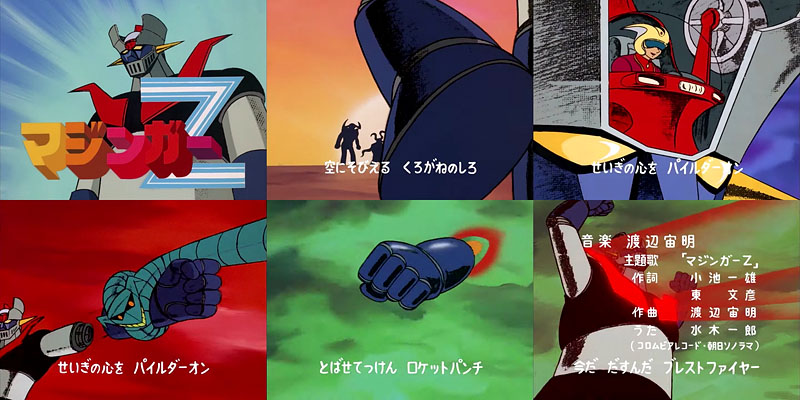
The title robot shows off its various gimmicks in Mazinger Z's opening credits, which describe it as "a fortress of iron, towering into the sky."

Mazinger Z setting art. The Hover Pilder that serves as its cockpit, and the Jet Scrander support mecha, prefigure similar gimmicks in later Sunrise robot shots.
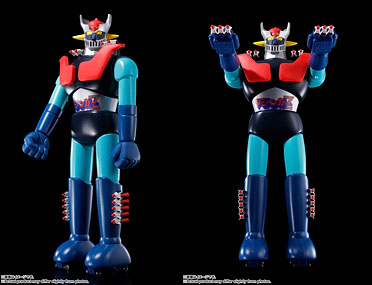
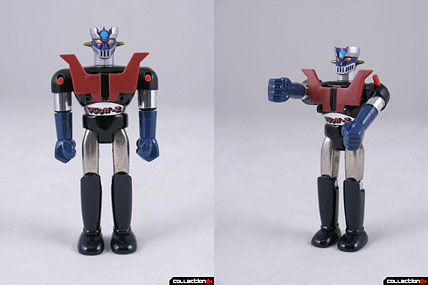
Left: A 2024 reissue of the "Jumbo Machineder" Mazinger Z released by Bandai's Popy subsidiary in 1972. This huge toy stands 600mm (about two feet) tall.
Right: A 1999 reproduction of the original 1974 "Chogokin" Mazinger Z, cast from heavyweight zinc alloy. Images courtesy of CollectionDX, whose in-depth review you can read here.
During the four years that passed between the birth of Soeisha and its tranformation into Nippon Sunrise, the newborn company would develop a business model in which it collaborated with toy company sponsors to create original works, then claimed a share of the merchandising sales in the form of royalties. For now, this royalty income would be going to Soeisha's parent company, Tohokushinsha.
Masao Iizuka — Gundam-Mono: The Men Who Made Gundam
—I gather that when you're creating original works, you make the main robot first.
That's right. At Sunrise, the robots come first. (laughs) It all starts with creating a toy—that is, a robot—that the main sponsor can make money selling.
—Then you create the worldview setting and decide on the cast of characters, and finally you put together a rough story. After that, the content of the actual work is up to creators such as as the series director and scriptwriters. Of course, the director and scriptwriters might be participating even before that, and you're coming up with ideas together. Is it fair to say that's the process by which they're made?
Exactly. That kind of process isn't necessary when it's based on a preexisting original work, but the drawback is that then you have to pay royalties to the original creator. With our own originals, all of that becomes income for the company, which is appealing in business terms. But unlike with a preexisting work, there's a definite risk that it won't be accepted in the marketplace. No matter what, the tastes of the creator will always come to the forefront, and there's a possibility they may not be aligned with the trends and demands of the public.
The animator, character designer, and manga artist Yoshikazu Yasuhiko, who worked on many of the company's early giant robot series, observes that this sponsorship arrangement gave Sunrise a considerable amount of creative freedom.
Yoshikazu Yasuhiko — Motion Picture King Vol.7
I think it's still like this now, but with robot anime, the sponsors don't interfere at all in the content of the story. The important thing is what kind of product they're going to sell, so they don't care about anything except concepts like how it combines or transforms. "Come up with the story on your own," they'll say. What a world, eh? (laughs)
And as Takayuki Yoshii points out, it also created a slightly unexpected incentive structure for the company.
Takayuki Yoshii & Gundam-Mono: The Men Who Made Gundam
—In that case, putting it in extreme terms, Sunrise could consider a work successful as long as the sponsor's toys are selling, even if it doesn't get audience ratings.
That's the first priority. With normal animation, you try various things to get the ratings the TV station wants. But in the case of Sunrise, first and foremost it's about accommodating orders from the sponsors.
Even when you're turning an original manga into an anime, I suppose you have creative restrictions such as "we have to make it just like the original story." When Sunrise was making its own original works, the sponsors had their demands, and there were the constraints of production management. But as strong as those restrictions were, there was an equally increased range of creative freedom.
I think that's a balance that came about quite naturally. If it were only about stronger restrictions, the creators would have lost their motivation. But even though there were a lot of constraints, as long as you met them, you could do whatever you liked. I think that balance was important.
It took some time for this model to evolve, however. At the beginning, the newly established Soeisha and its founders had only one focus—survival.
The fledgling company got off to a slow start, producing only two TV series during its first two-and-a-half years of operation. The first of these was Hazedon, which made its broadcast debut in October 1972, just one month after Soeisha and Sunrise Studio were formally established.
 ハゼドン
ハゼドン| TV BROADCAST | |||
| Fuji TV • Thursday 7:00-7:30 PM October 5, 1972 to March 29, 1973 (26 episodes) |
|||
| MAIN CREDITS | |||
| Planning • original story | Video Client | Original plan | Hajime Yagurazawa |
| Key art | Haruyuki Kawashima | Coordinator | Michio Shinohara |
| Chief director (チーフディレクター) |
Osamu Dezaki (ep.1~10) Fumio Ikeno (ep.11~26) |
Setting manager | Masao Maruyama |
| Character design | Toshiyasu Okada (ep.11~26) |
Animation director | Kazuhiko Udagawa |
| Art director | Katsumi Bando |
Director of photography | Sumio Takahashi Kasami Kitagawa |
| Sound director | Toshio Sato |
Production manager (制作担当) |
Yoshinori Kishimoto Osamu Hirooka |
| Production | Soeisha, Fuji TV |
||
| ADDITIONAL CREDITS | |||
| Production cooperation | Sunrise Studio, Wako Production | ||
Quite unlike the sci-fi action works for which Soeisha and Sunrise would later be known, this debut series was a lighthearted cartoon about the adventures of a little fish and his undersea friends. The 1997 "Sunrise Anime Super Data File" describes Hazedon as follows:
Fish of all kinds live together in an undersea world. Hazedon is a young goby who sets out on a journey to the South Seas, wearing a seashell pendant that was a memento of his mother, to keep his promise to become the strongest fish in the world. Along the way he meets the mermaid Shiran and the puffer fish Puyan, who join him as he continues his journey.
In the first work whose production Sunrise was involved in. Nonsensical gags and romantic comedy unfold within a fairytale style and worldview. Though this work was aimed purely at children, Shiran's strangely sexy design was quite memorable.
In his "Atom's Genes, Gundam's Dream" interview series, Ryosuke Takahashi describes this project as a gift from Fuji TV to its longtime partners, using the Japanese term 御祝儀作品 (goshūgi sakuhin) to liken it to the cash present given to a newly married couple.

Scenes from Hazedon's opening credits.
In any case, plunging straight into the production of a weekly series required Sunrise Studio—the production side of the new business—to rapidly assemble a staff. Yoshinori Kishimoto, one of Soeisha's seven founders, served as president of Sunrise Studio and Hazedon's producer, with his fellow Mushi Pro veteran Katsumi Bando as art director. They were aided in their time of need by two founders of the Madhouse studio, with Masao Maruyama supervising the scripts and the legendary Osamu Dezaki as the initial director.

Left: Katsumi Bando and Masao Maruyama in 2002, when they were interviewed for the "Atom's Genes, Gundam's Dream" series.
Right: Osamu Dezaki, prior to his death in 2011.
The core team at Sunrise Studio was very small. In Kiyomi Numoto's account below, "Kicchan" and "Marutan" are nicknames for Kishimoto and Maruyama.
Kiyomi Numoto — Atom's Genes, Gundam's Dream Episode 4
Sunrise Studio began with Kicchan, Marutan, and myself. Marutan was doing the scripts, so he'd bring in his work when it was finished, but it was Bando who was most often in the studio. Kicchan was in charge of production, Marutan was writing, I was doing everything from drawing to finishing, and Bando was doing the backgrounds. That's how we did Hazedon.
Masao Iizuka — Atom's Genes, Gundam's Dream Episode 6
In the beginning, Kicchan (President Kishimoto) was the only production person... During Hazedon, their president Kicchan was doing the production work himself. He laid out all the cuts on the floor.
The new studio, which would later become Sunrise Studio 1, was a rented space on the second floor above a coffee shop called "Yutaka."
Ryosuke Takahashi — Atom's Genes, Gundam's Dream Episode 6
This was the kind of old-style coffee shop that's almost disappeared from the Tokyo Metropolis. Since it was right underneath the studio, and the studio itself didn't have space for a conference room, we held all our meetings and conferences here. I also drew and revised storyboards, thought things over, and ate my meals here. It was really a great help.
Later on, it became a record store, a video store, and then a game corner, and I think it's now a florist... The public bathhouse behind it, Daishiyu, was also very helpful, but I hear it's gone out of business and the site is now a vacant lot. It's sad, but I'll have to take a peek next time.
Katsumi Bando & Ryosuke Takahashi — Atom's Genes, Gundam's Dream Episode 8
Bando: The initial Sunrise was a studio above Yutaka, and I went to see it with Kicchan. Anyway, the floor was really uneven.
Takahashi: That's terrible.
Bando: Bando: Yeah. So we pulled up the flooring, and put something under it to make it more stable. Kicchan and I brought in the desks and everything else all by ourselves.
Ryosuke Takahashi describes art director Katsumi Bando as "the industry's human resources manager," and he apparently played a key role in populating Sunrise Studio with production staff. In particular, Bando was able to reunite many of the staffers who had worked under Kishimoto on the 1971 TV series Wandering Sun.
Katsumi Bando & Ryosuke Takahashi — Atom's Genes, Gundam's Dream Episode 8
Bando: When they left Mushi Pro, both Marutan and Kishimoto were in production. Marutan had just formed his own production company, and as it turned out, there was nobody over at Kishimoto's place...
[Takahashi:] Sunrise and Madhouse, now two of the liveliest and most active production companies, were born in 1972. As for the reason Sunrise was unable to gather production staff, the previous year, Mr. Kishimoto had been working on Wandering Sun (April 8 to September 30, 1971). Then Mr. Maruyama did Kunimatsu-sama no Otoridai (October 6, 1971, to September 25, 1972), and ultimately the Kunimatsu team moved directly over to Madhouse. My guess is that, since it had been about a year since Mr. Kishimoto's Wandering Sun team was disbanded, they'd all scattered in the meantime. Mr. Bando's following testimony supported this idea.
Bando: I just remembered this, but Iwa-chan came in a little later. Since he still had some things to sort out at Mushi Pro, he wasn't there during Hazedon. So Kicchan said "Bando, please do something!" I persuaded Masaaki Sakurai, Hiroshi Otake, Susumu Ishizaki, and so forth, who hadn't yet decided where to go, saying "Come and back up Kishimoto."
But they didn't have a leader... As production assistants, their skills weren't that high. Osamu Hirooka was wandering around somewhere, so I said "Hirooka, come help out a little." That's how Hirooka ended up working on Hazedon.
[Takahashi:] Masaaki Sakurai, Hiroshi Otake, Susumu Ishizaki, and everyone else Mr. Bando had mentioned were all connected to the Wandering Sun team.
As it turned out, Osamu Dezaki's tenure on Hazedon was fairly short, and he left the production after ten episodes.
Ryosuke Takahashi — Sunrise World Creator Interview 15
Unlike today, it was an era when there wasn't any money to create works. So it's a question of how you feel about having no money. Since Mr. Dezaki was a creator, he went in the direction of "I want to make it like this" and "I want to do that." But Soeisha's priorities were schedules and budgets. As a result, Mr. Dezaki lost interest along the way, saying "This isn't a production company I can stay with," and he left in the middle. Though Mr. Dezaki had been sent over from Madhouse to Soeisha, he ended up going back.
I'm not sure how Hazedon was made after that, but its broadcast had been decided even if they didn't have a series director, so the production probably continued under the guidance of the directors of each individual episode.
Soeisha and Sunrise Studio were now in business. But it wasn't until October 1973, a year after Hazedon's debut, that the new company finally managed to get another show on the air.
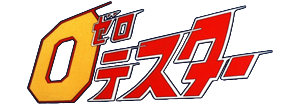 0テスター
0テスター| TV BROADCAST | |||
| Fuji TV • Monday 7:00-7:30 PM October 1, 1973 to December 30, 1974 (66 episodes) |
|||
| MAIN CREDITS | |||
| Planning | Kansai TV Tohokushinsha |
Original story | Yoshitake Suzuki |
| Music | Naozumi Yamamoto | Mechanic design & concept | John Dedowa |
| Character design | Munehiro Minowa | Chief director (チーフディレクター) |
Ryosuke Takahashi |
| Animation director | Kazuo Nakamura (ep.1~39) | Art director | Jiro Kono |
| Director of photography | Horofumi Kumagai (ep.1~39) Yukuhiko Sano (ep.40~66) |
Recording director | Toshio Sato |
| Literature manager | Masao Tokumaru (ep.1~39) Eiji Yamaura (ep.40~66) |
Producer | Hiroshi Miwa (Kansai TV) Yoshinori Kishimoto |
| Production | Kansai TV, Soeisha | ||
| ADDITIONAL CREDITS | |||
| Cooperation | Crystal Art Studio | Production cooperation | Sunrise Studio (ep.1~39) |
Soeisha's second work, pronounced "Zero-Tester," is often characterized as an anime version of Thunderbirds, a 1965 science fiction TV series created by Gerry and Sylvia Anderson for British television. The "Sunrise Anime Super Data File" describes 0-Tester as follows:
In 2100 A.D., Earth is targeted by a mechanized race called the Armanoids. Responding to a series of space accidents, Dr. Tachibana of the Future Science Development Center creates the specialized mecha Tester-1 through Tester-5, and assembles a team of pilots to operate them. These people, who protect the Earth in extreme situations with zero life support, are known as the 0-Testers.
This work was created aiming for an effect like that of the British TV puppet show Thunderbirds. That influence can be seen in the stories about space accidents, and the transforming and combining Tester mecha. However, it wasn't well received by younger age groups, so after episode 39 it was retitled 0-Tester: Save the Earth! and the focus changed to confrontations with the giant monsters known as the Gallos Seven.
Thunderbirds began airing in Japan in 1966, and proved to be a huge success in terms of both audience ratings and merchandise sales. The plastic models released by Imai—and subsequently reissued by Bandai—were particularly popular. Tohokushinsha, which produced the Japanese version of the series, had also secured the Japanese licensing rights and thus made a lot of money from the Thunderbirds phenomenon. So it was only logical that Tohokushinsha's president would instruct his subsidiary Soeisha to create a similar series for its followup work.
Kiyomi Numoto & Ryosuke Takahashi — Atom's Genes, Gundam's Dream Episode 4
Numoto: He has a bad reputation, but President Banjiro Uemura's words carried a lot of weight. He told us to make money. Nobody ever talked about making money in the Mushi Pro days, and if you said something like that, people would despise you. (laughs)
Takahashi: Well, there was that kind of atmosphere.
Numoto: But we'd learned firsthand that we couldn't keep going if we didn't make money. In that sense, he was very perceptive. President Banjiro didn't know anything about ideas like mecha design, but he knew Thunderbirds had sold well. He explained that in detail, and he already knew that Japan would follow the same path in the future.
Takahashi: Wow, not bad.
[Takahashi:] Mr. Banjiro Uemura, the head of Tohokushinsha, was something of a self-made man. It's commonplace that people like that are fiercely criticized, and because of Mr. Uemura's slender build, you'd often hear people inside and outside the company calling him things like "that crow Banjiro!"
Numoto: So I thought about what new things we could do in a Japanese version of Thunderbirds, and 0-Tester is what I came up with. It was the starting point of Sunrise's original works. I can be very clear about that, since I was responsible for planning it.
Takahashi: Wasn't Hazedon the first one? Anyway, I was pretty sure Hazedon was purely a gift from Fuji TV. So after that, Sunrise discussed what they should make next, and I figured that was 0-Tester. But it wasn't Sunrise's seven founders who first suggested that, but President Banjiro?!
Numoto: It was Ban-chan.
Takahashi: So it was President Banjiro Uemura after all!
Numoto: Although President Banjiro didn't tell us to do SF, just something profitable like Thunderbirds. Then we tallied up all the appealing things about Thunderbirds, so it was only natural that we decided to make a Japanese version of it.
Masao Iizuka — Atom's Genes, Gundam's Dream Episode 6
Mr. Yamaura said that Mr. Uemura told him to make an animated version of Thunderbirds because the Thunderbirds toys sold so well... While Mr. Yamaura was walking back from Fujimidai Station, he saw an appliance store by the railway tracks, and just as he was trying to decide on a title he noticed the word "tester." There were issues with calling it 1-Tester, so he extended it to "0-Tester." (laughs)
Mr. Uemura's line of business was buying foreign TV programs and then selling them in Japan. He'd even created a studio for dubbing the sound. I thought he was an amazing and far-sighted entrepreneur. And 0-Tester turned a profit, too.
Kiyomi Numoto — Atom's Genes, Gundam's Dream Episode 4
Bandai was supposed to merchandise 0-Tester on a much larger scale, but right at that moment the price of materials skyrocketed due to the oil crisis, and toys are basically just lumps of plastic. So the plan was scaled down, but 0-Tester still sold well.
The series did indeed prove reasonably successful, as did Bandai's toys and plastic models. After its rebranding as 0-Tester: Save the Earth!, the broadcast run was extended to a total of 66 episodes.
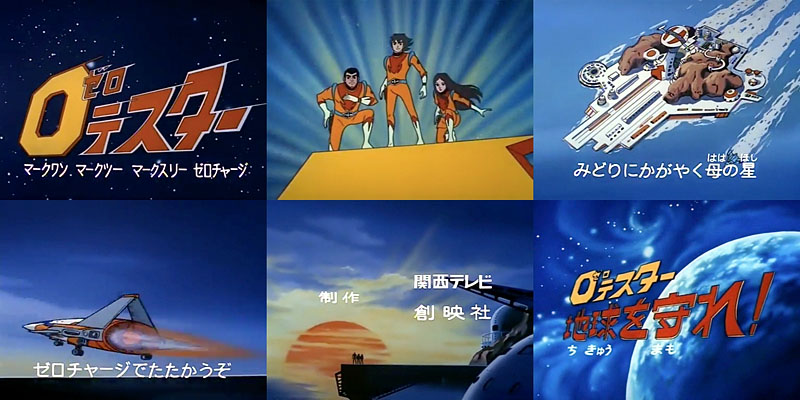
Scenes from 0-Tester's opening credits, and the new title introduced with episode 40.
Soeisha's lineup of reliable freelancers continued to expand as 0-Tester was taking shape. Some of these were former comrades from the Mushi Pro days, while others were up-and-coming new talents who would play major roles in future Sunrise works—and in the history of anime.

Left: Haruka Takachiho in 2002, when he was interviewed for the "Atom's Genes, Gundam's Dream" series.
Right: Kenichi Matsuzaki in 2002, from the "Gundam-Mono" interview book.
Center: Kazutaka Miyatake in 2023, when he was interviewed for the Sunrise World website.
Before leaving to join the toymaker Takara, Soeisha founder Kiyomi Numoto made contact with a group of college science fiction fans who would later be known as Studio Nue.
Kiyomi Numoto & Ryosuke Takahashi — Atom's Genes, Gundam's Dream Episode 4
Takahashi: You left both Soeisha and Sunrise Studio very early on. At what point did you leave? Was it before 0-Tester entered production?
Numoto: Yeah. After we'd finished all the planning.
Takahashi: I'd like to hear a little more about that, please.
Numoto: There was somebody called John Genowa or Dedowa, I forget which, who did mecha design for Thunderbirds. On 0-Tester, where I was provisionally responsible for the mecha design, I began by contacting Mr. Minowa, an animator who was then at Tatsunoko, as well as the predecessor to Studio Nue.
At the time, Nue hadn't yet become "Crystal Art," and it was still just a bunch of people from an SF fan club. So I gathered them at a coffee shop in Ikebukuro, and told them "I'll provide the coffee and cake, if you'll tell me all about SF." And yikes, about thirty of them showed up, and they talked and talked and talked... That's how it happened.
One of the group's leaders was Haruka Takachiho, who would go on to become a prominent science fiction author. In his interview for the "Atom's Genes, Gundam's Dream" series, Takachiho gives a detailed account of the group's origins, its early career as Crystal Art Studio, and its eventual decision to dissolve and reconstitute itself as Studio Nue in order to escape an awkward social situation.
Haruka Takachiho & Ryosuke Takahashi — Atom's Genes, Gundam's Dream Episode 10
Takachiho: I think it was around 1972, but Naoyuki Kato, Kenichi Matsuzaki, Kazutaka Miyatake... all of them except me were about to graduate from university or vocational school, and we'd started discussing what to do about finding jobs. At a meeting of the dōjinshi "SF Central Art"—
Takahashi: Eh?! Not Crystal Art? It was Central Art?
Takachiho: The dōjin club Matsuzaki was running was called "SF Central Art," but the title of the club bulletin it published was "Crystal." We'd meet once a week at a coffee shop in Ikebukuro, and we'd all talk about "SF is like this" and "Art is like that."
I was still in my second year of university, but the main members all had to think about getting jobs... As they were discussing where they should find employment, I casually suggested "Rather than joining a company and being constrained, wouldn't you rather try doing jobs that make use of SF?" They all said "That would be fun, but first let's check and see whether jobs like that exist." If the jobs didn't exist, then we couldn't do that, right?
Naoyuki Kato had a classmate working at Sunrise, who asked whether we'd like to do mechanic design for their next new program. By that point, Miyatake had already been working a lot on "robot internal diagram" orders for Ishimori Production and Dynamic Production. If it was an animated mecha show, we thought we could do it... So that was the first one. Another was an approach from the SF veteran Mr. Masahiro Noda, saying "I'm going to be making an education program for preschoolers, so I can throw some illustration work your way."
...So, for the time being, we decided to form a company to do those two jobs (since Fuji TV wouldn't have been able to work with us unless we were a business organization). We averaged together "SF Central Art" with "Crystal" from the club bulletin, established a limited company called "Crystal Art Studio," and started doing business... I think in Higashi-Nagasaki? I feel like that was probably at the beginning of 1973.
Takahashi: The new job was 0-Tester, right?
Takachiho: There were four or five of us, but we all went as a group and visited each place in turn. We went to Fuji TV about Hirake! Ponkikki. They told us to do some drawings first and bring them in. "Right, right," we said.
Next we went to Sunrise Studio, and Mr. Numoto showed up to tell us about mecha design. We didn't know anything at all about animation or anime, but we'd been studying things related to SF for a long time, and we also understood scientific subjects, so our main topic of discussion was how to reconcile all these aspects. Then we turned in some sample drawings (we all had to work together to turn the useless, terrible drawings by a certain foreign designer into something decent)... and we kept on working like that.
Meanwhile, we divided up the business responsibilities. We decided Matsuzaki would be responsible for Sunrise, and I'd be in charge of Hirake! Ponkikki. So I didn't have much to do with Sunrise at first...
Takahashi: I'm sure I first visited you when you were in Higashi-Nagasaki.
Takachiho: At that point, everyone was sleeping there. We didn't have our own rooms, and all the members would just lie around the company office, like in an anime studio.
Takahashi: You must have been associated with many different places, but I only knew about Nue through Sunrise. So what was Nue's work like? Was Sunrise a big part of it?
Takachiho: No, Hirake! Ponkikki was the biggest. At any rate, it kept us busy. That's what led to us becoming Studio Nue. The Ponkikki workload was steadily increasing, but the things we drew for it didn't become hits like "Oyoge! Taiyaki-kun." (laughs) There was so much detailed work, and the fees never increased... When we created the company, the founding ethos was "let's do SF," so this situation wasn't quite...
Meanwhile, Ponkikki was gradually overwhelming us. If this kept up, we'd never be able to do what we'd set out to do. But it would be hard to say "Please let us quit Ponkikki" after all they'd done for us. We thought we might as well just dissolve the company, so we did that instead.
The Hirake! Ponkikki mentioned by Takachiho was a long-running children's entertainment program similar to Sesame Street. Launched in 1973, the program continued for 20 years. The 1975 song "Oyoge! Taiyaki-kun" became a record-breaking hit single after it was featured on Ponkikki, but clearly Crystal Art Studio's future lay elsewhere...
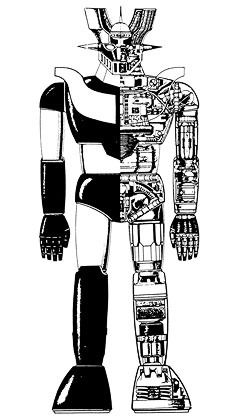
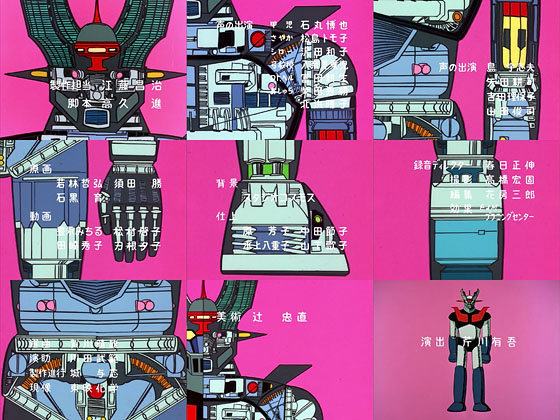
Cutaway illustration for 1972's Mazinger Z by Kazutaka Miyatake, and its depiction in the ending credits.
Though the mechanical design for 0-Tester is credited to a (possibly mythical) foreign designer named John Dedowa, in practical terms the designs were created by the members of Crystal Art Studio. Among them was an artist named Kazutaka Miyatake, who had made his anime debut when he was still a student by providing the detailed cutaway drawings used to illustrate the ending credits of Mazinger Z.
In an interview for the Sunrise World website, Miyatake recalls his unnerving audition with Soeisha's Kiyomi Numoto.
Kazutaka Miyatake — Sunrise World Creator Interview 19
—Mazinger Z began airing at the end of 1972. Crystal Art Studio, the predecessor to Studio Nue, launched that same year as well.
And 1972 was also the year in which Soeisha, the predecessor to Sunrise, started up. Naoyuki Kato of Nue had a senior art-school classmate there who told him they were looking for designers, so I went over there with two hundred of my design drawings. And there I met Mr. Kiyomi Numoto.
—He was one of seven members who became left Mushi Pro and established Soeisha and Sunrise Studio, right?
Mr. Numoto had very keen eyes. One by one, he looked at the designs I'd brought, and after taking in the whole picture his eyes would move as he scrutinized the key points. His gaze was very sharp. He finished looking at all two hundred of them in about thirty minutes, then gave me the order "We want distinctive mecha for the three protagonists. Please do that." He had no other requests at all. So I went home and finished up the designs.
—That's all there was to the order?
That was it. So when I designed them, I added the quirk that the aircraft piloted by the three characters combined to form a single mecha. But aircraft have broad wings and a flat shape, so I had a hard time giving them the sense of volume that kids would want when they were turned into toys. After all, it was my first professional design job.
—And the design you submitted became 0-Tester's Tester-1.
That's right, and Mr. Numoto said "We'll take it." Then he went on to say "We'll take it, but I'm keeping this to myself. I can't show such an inept drawing to the other staff."
—That's harsh.
"You have no idea how to draw," Mr. Numoto said. "You have to start by knowing how to draw. You do calligraphy, don't you?" And indeed, I'd reached the fifth dan. He told me that when working as a designer in the animation world, calligraphy techniques were actually a hindrance, so I should get rid of them.
—How could they be a hindrance?
For example, when you look at this cup sitting here, or a car parked in front of you, you ask yourself where the buttsuke is in the shape and whether it has any hane. Buttsuke and hane are techniques for writing text characters, not for designing. That had become a habit for me, so I wasn't even conscious of it.
—So that was it.
Mr. Numoto had been the head of Mushi Pro's animator training school, so I guess he couldn't tolerate the idea of abruptly putting down the point of the pencil and then pulling on it with a flick. Real objects aren't like that. The point of the pencil gently descends onto the paper, moves, and then gently rises into the air again. That's how you draw perfectly parallel lines, he said. And the human hand is designed to pivot at the wrist and at the elbow so you can draw big curves. It's no good if you just draw by following the strokes, he told me, and you have to consciously control the pencil yourself. I still remember every word Mr. Numoto said..
—And then you practiced?
Right. I drew parallel lines on straw paper until it turned pitch black, and then after I'd done my parallel line training, I'd practice radial lines. First I'd draw them from the outside into the center, and then from the center to the outside. I kept that up for about two weeks, and then he said "That's enough" and told me to draw my original design over again.
—So the design was finally officially accepted.
But when I took in my redrawn designs to show Mr. Numoto, he'd already left Soeisha. (laughs) He'd gone to join Takara, so I visited him there, and he offered me work for Takara as well. That's how I got involved with Microman.
The final designs included a fleet of Thunderbirds-style specialized vehicles, led by the three-part combining Tester-1—a gimmick reminiscent of the Ultra Hawk 001 from the 1967 special-effects show Ultraseven. Miyatake and his fellow Crystal Art Studio members produced detailed cutaways and diagrams of their creations for promotional purposes, following in the tradition established by Miyatake's illustrations for Mazinger Z.

0-Tester mechanical designs by Crystal Art Studio. The original concept for the island base was by Katsushi Murakami of Bandai's Popy subsidiary.
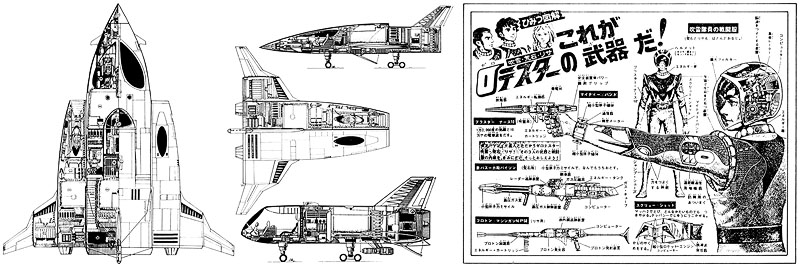
Internal cutaway views of the Tester-1 and its components by Kazutaka Miyatake, and equipment diagrams created by Crystal Art Studio for magazine publication.
With Numoto's departure, Eiji Yamaura became primarily responsible for planning the new series. He turned to scriptwriter Yoshitake Suzuki, another Mushi Pro veteran who had previously contributed episode scripts to Hazedon, to finalize the story and complete the proposal so that the project could be approved.

Left: Yoshitake Suzuki in 1978 and 1987.
Right: Suzuki in 2002, when he was interviewed for the "Atom's Genes, Gundam's Dream" series.
Suzuki, also known by the alias Fuyunori Gobu which he used for episode scripts and his many "chief writer" and "series structure" credits, went on to become a mainstay of Soeisha's and Sunrise's works. His working relationship with Yamaura went back to their days at Mushi Pro.
Yoshitake Suzuki — Zambot 3 / Daitarn 3 Chronicle
I was originally at Mushi Pro, and that's where I first met Mr. Yamaura. At the time, Mr. Yamaura was in the photography department, and I was an assistant director and production assistant, so our relationship was purely professional. After that, Mushi Pro's management went awry, and everyone started leaving for other companies. I basically wanted to write scripts, so I quit Mushi Pro and began walking the path of a scriptwriter. And this may sound weird, but Mr. Yamaura and the others created their own company because they said they had to make a living. That was Soeisha, the predecessor to Sunrise.
At the time, I was writing scripts elsewhere. Then the freshly created Sunrise called me in. Before I arrived, it seems they'd brought in Madhouse's Mr. Maruyama (Masao Maruyama, currently the president of Madhouse) and the director (Osamu) Dezaki, and though I don't know much about it, I was called in as a replacement when they left Sunrise. I joined in as one of the writers on Hazedon, and at the time, Mr. Maruyama was serving as literature manager.
After that came 0-Tester, which was inspired by Thunderbirds. Because that had been a hit, Soeisha's backer Tohokushinsha wondered whether they could sell another round of similar toys, so they asked us to do it.
Suzuki's work on the 0-Tester proposal, however, took place under less than ideal conditions.
Ryosuke Takahashi — Atom's Genes, Gundam's Dream Episode 3
Mr. Yoshitake's pen name "Fuyunori Gobu" is inscribed on countless Sunrise works. I call him Mr. Yoshitake based on his real name, Yoshitake Suzuki, which also appears as an original creator of 0-Tester, Zambot, and Xabungle. Mr. Yamaura says that when he was a newlywed, he locked up Mr. Yoshitake in his own six-mat room and made him write a proposal in three days and nights without sleeping.
Once upon a time, I myself crashed in Mr. Yoshitake's room when he was a newlywed, spending several months there living in hell. I was working on a series that had stalled out when the producer and director both ran away, and I was going straight from writing scripts to storyboarding, over and over again. Well, whatever anyone says, he's one of the finest people in the anime world.
Eiji Yamaura & Ryosuke Takahashi — Atom's Genes, Gundam's Dream Episode 3
Yamaura: At that time, I'd just gotten married. We were renting an apartment less than a minute's walk from the Tachikawa Velodrome, with no bathroom and just six tatami mats of space. I remember Mr. Yoshitake stayed for three days at my place writing the proposal. Even though my wife was working as well, she had to sleep in the kitchen. We wracked our brains writing it. Under the circumstances, I think it's amazing we ended up producing more than sixty episodes of 0-Tester. But that was also a plan created through learning by imitation, right? And it was the first time everyone's role was listed in the credits.
Takahashi: From the series director and producers to the character designer, animation director, art director, color coordinator...
Suzuki's heroic efforts in putting together the 0-Tester proposal earned him an "original story" credit line. He would be similarly credited in Soeisha's Reideen the Brave and Sunrise's Zambot 3 and Xabungle.
Yoshitake Suzuki — Complete Works of Yoshiyuki Tomino 1964-1999
The reason I had myself listed as original story creator wasn't that I wanted to promote my own name in order to broaden the scope of my work. I actually had a different objective at the time. In short, back then all anime was based on preexisting original stories by manga artists. Even when the initial plan and the content of the resulting work were our own original creations, it was still standard practice to credit manga artists as the creators. But if people from the animation industry were planning and actually making the work, I wondered why we couldn't describe ourselves as the original creators.
In those days, it was manga artists who were highly regarded by the public, and the people working on anime production sites had a much lower status. We weren't really appreciated. These attitudes made us resentful and frustrated, so we fought a battle to put forward the names of people from the anime industry as original creators, in order to raise public awareness about our position. That was partly the stubborn pride of a small production company, but it was also the pride of an anime writer.

Left: Ryosuke Takahashi in 1986.
Left: Takahashi in 2002, when he was interviewed for the "Atom's Genes, Gundam's Dream" series.
Right: Takahashi in 2023, when he was interviewed for the Sunrise World website.
Series director Ryosuke Takahashi would go on to have a long-running relationship with Sunrise. In addition to providing us with vast amounts of historical detail and funny gossip through his "Atom's Genes, Gundam's Dream" interview series, Takahashi went on to direct landmark robot anime such as Dougram, Votoms, Galient, Layzner, and Gasaraki. By Takahashi's account, his recruitment to direct 0-Tester arrived at a point in time when he was uncertain about his future in the anime industry.
Ryosuke Takahashi — Sunrise World Creator Interview 15
I'd known the Sunrise founders ever since we were all at Mushi Production. The only one who was senior to me at Mushi Pro was Mr. (Kiyomi) Numoto, and all the other people involved in founding the company joined after I did. I guess that made me their senior, but only by a few months. Of the Sunrise founders, I was closest to Mr. (Eiji) Yamaura. Anyway, even though though they were my juniors, they were all older than me because they'd joined Mushi Pro in mid-career. It was something like that, but my memories of the time are pretty fuzzy.
—It's already been half a century.
I joined Mushi Pro in 1964, so that's more than half a century. Eventually they'd all left Mushi Pro, and I was doing various different things on the fringes of the animation industry. Rather than working on anime full-time, I'd been wandering around on the fringes of the anime world drawing manga, hanging around with people doing plays, and shooting commercials. Then, when they were producing 0-Tester, which was to be Sunrise's second work, they called me in to direct it.
Ryosuke Takahashi — Sunrise Animation 2001
The year after the company was founded (1973), Hazedon ended and all their production staff left, so they didn't have anyone at the production site. Then a senior I was close friends with got in touch with me. I hadn't yet decided whether I wanted to keep working in anime at that point, but they didn't have any other candidates for a director, and I didn't have anyone else to look after me. That's why I signed up for 0-Tester.
Ryosuke Takahashi — Sunrise World Creator Interview 15
I happened to be wavering between things at that point, and I was friendly with Mr. Yamaura and Mr. Numoto, so they ended up saying "How about that guy?" Then they called me in.
I wasn't yet established as a director back then, and I hadn't even been going in to other people's studios to direct episodes. My directing experience was all the level of individual episodes, and I wasn't a lead player. Though I worked on things like Wonder 3, Dororo, and Goku no Daibōken, I'd only been doing episode direction while surrounded by ace-class people, and I wasn't even sure whether I was going to make a living in anime. That was my situation when I was asked to do the job, so I said "I'll give it a try anyhow." In that sense, 0-Tester was like a fresh start for me in anime. Fortunately, the products did well commercially, and the broadcast run was extended.
—Were the plan and the content of the work already decided at the point when you got involved with 0-Tester?
That's right. I hadn't participated in the planning. 0-Tester was created by analyzing the structure of Thunderbirds, which had been a big hit as a special effects program, and reconstructing it for Japanese animation. By the time I joined in, the design of the mecha had been decided as well. Then I was called in at the stage where they were creating the scripts for each episode. It was an enjoyable job, and I was still young, so I pretty much never went home and just hung around the studio while I was working on it.
Takahashi's association with Soeisha was to be a temporary one, however. Despite the success of 0-Tester, he wasn't yet sure that he could make it as a director, and his confidence took a major blow from another anime series that debuted just as 0-Tester was wrapping up...
Ryosuke Takahashi — Sunrise World Creator Interview 15
Just as I was starting to feel I'd created a fairly successful work, Space Battleship Yamato started. This was still in 1974, but our broadcast started in April, and theirs in October. Watching it, I was devastated as a creator. Space Battleship Yamato was leaps and bounds ahead of the animation I was making. So I asked to be excused from directing Sunrise's next work, saying "I'm going to go back and retrain for a while." Mr. (Yoshiyuki) Tomino ended up doing the following Reideen the Brave, and I parted ways with Sunrise for the first time.

Left: Yoshikazu Yasuhiko in 1982.
Center: Yasuhiko in 2002, when he was interviewed for "Gundam-Mono" and "Atom's Genes, Gundam's Dream."
Right: Yasuhiko in 2021, when he was interviewed for the Sunrise World website.
Another Mushi Pro veteran whose involvement in 0-Tester would lead to bigger things was Yoshikazu Yasuhiko. Previously a key animator at Mushi Pro, Yasuhiko found that Soeisha's contining manpower shortage gave him an opportunity to try out new roles such as animation direction, storyboarding, episode direction, and even scriptwriting—prefiguring the variety of roles he'd play in the Space Battleship Yamato series and later Sunrise works.
Yoshikazu Yasuhiko — Motion Picture King Vol.7
When Mushi Pro went bankrupt, I was wondering where to go. If I'd gone to Madhouse, they might have said "We don't need people like you." But there was someone I knew at Soeisha, so I figured they'd probably give me some work if I went there.
—What was your last job for Mushi Pro?
I think it was Little Wansa. Mushi Pro itself was running out of work, so they got the whole company together to do that.
—So there were still people at Mushi Pro?
They had loads of people. It's because they had so many people that they went bankrupt. (laughs)
—And after that, you did animation direction on 0-Tester at Soeisha.
That was a long-running work, and at first they hired me as an ordinary key animator, but I was getting fed up with all the revisions. Since they didn't have enough people anyway, they gradually started asking me to do more and more. As I came to understand this, I figured I could take advantage of their weakness and started declaring that I could do other things as well, suddenly saying "let me draw storyboards" and "I wanna direct, too."
—That experience of being an episode director must have come in useful later on.
Or rather, I said I became an animator because I couldn't be an author, but I still had a lot of lingering attachment to the idea of authorship. Many people might consider this a rude thing to say (laughs) but being an animator is pretty boring.
Yasuhiko began storyboarding for 0-Tester with episode 41, broadcast in July 1974, and debuted as an episode director with episode 46, which aired in August of that year. He continued contributing to the series until its conclusion in December 1974, by which time the planning of Soeisha's next series had begun.
Yoshikazu Yasuhiko — Motion Picture King Vol.7
—And how was it when you first tried doing storyboards?
Simply put, I thought it was easy. That's because the work called 0-Tester was also at a pretty low level. It's cheeky of me to say that, but it's a good thing, too. I couldn't say that if it had been a high-level work.
—Were you working on Space Battleship Yamato at that point?
Yamato was later on. That was after I did Reideen the Brave. I think they did about 70 episodes of 0-Tester.
—Do you feel 0-Tester was an innovative work for its time?
Well, it allowed me to do things like that. Starting with key animation, over a long period of time I was able to do various things like storyboards, scripting, and animation direction. It's said that anime doesn't have such a thing as authors, but I unknowingly went in the direction of authorship. When we did Reideen the Brave, I had a stronger awareness that was what we were doing.
With two TV series to its name, and working relationships with many energetic and imaginative creators, Soeisha had survived its first years as a newborn company. The question, of course, was what to do next.
Around 1974, a new department known as the planning office was created specifically to develop ideas for animation projects, create proposals, and pitch them to sponsors. Once a proposal had been approved and a sponsor secured, the project would then be handed off to a producer and the production work would begin in earnest.
Eiji Yamaura, who had taken over the planning duties with Kiyomi Numoto's departure, turned to another Mushi Pro veteran to back him up. In his new role as the planning department's desk chief, Masao Iizuka would become Yamaura's indispensable right-hand man.

Left: Masao Iizuka in 1980.
Right: Iizuka in 2002, when he was interviewed for "Gundam-Mono" and "Atom's Genes, Gundam's Dream."
As well as helping Yamaura craft proposals, Iizuka was also responsible for gathering and archiving all the materials generated in the development and production process, from planning documents and design art to scripts, storyboards, and animation cels. This was similar to his role at Mushi Pro, where he assisted Osamu Tezuka in implementing a "bank system" which allowed animation sequences to be repurposed in later episodes.
Masao Iizuka & Ryosuke Takahashi — Atom's Genes, Gundam's Dream Episode 6
Iizuka: Well, in my last days at Mushi Pro, I was in a position called "planning and sales materials"... I didn't really know what that meant. (laughs) At Mushi Pro, nobody was even keeping track of the original film plates, so I was up every night doing it...
Takahashi: Organizing the film?
Iizuka: I wasn't just organizing it, I was doing everything from selling prints to placing orders with photo labs and processing cuts. (laughs) It was a total mess at the time. Some of the film plates were at Mushi Pro's headquarters, some were at Tezuka-sensei's house, some of them were at other studios (laughs), some were over at Toyo Laboratory (now Imagica)... I thought I was in no position to join some "new company," so I turned them down.
Takahashi: And that was Sunrise?
Iizuka: Right. At first, I wondered what they could do with just production and sales... (laughs) Since they didn't have any actual makers. (laughs)
Between his doubts about the new company's prospects, and his continuing responsibilities at Mushi Pro, Iizuka didn't join Soeisha until after 0-Tester had been launched and the company founders were trying to decide what to do for a followup.
Masao Iizuka — Gundam-Mono: The Men Who Made Gundam
They ended up being happy that 0-Tester was well received. But then they had to write a new proposal every week as they wondered what to do next. At that point I heard Mr. Yamaura didn't have time to write all those proposals himself, so I said "Oh well" and started helping him out. I was thinking I might be done with anime since I was already thirty years old, but Mr. Yamaura and the rest of the staff were calling me on the phone every day. (laughs)
Masao Iizuka & Ryosuke Takahashi — Atom's Genes, Gundam's Dream Episode 6
Iizuka: When I came over from Mushi Pro to Soeisha, it was just to format the proposals. I was purely assisting Mr. Yamaura as a side job... But my take-home pay was higher than Mr. Yamaura's. When we were walking together, he'd fumble at my chest. I'd say "Huh?" and he'd say "Cigarette." (laughs)
Speaking of money, he'd say "I can't afford the teahouse for our meeting, I'll pay you back when my advance payment clears." It would often end up with me gathering receipts from Mr. Yamaura's pockets, writing up invoices, and having him send them to Tohokushinsha for reimbursement.
Takahashi: He was bumming cigarettes off you! (laughs)
Iizuka: The people in Kami-Igusa's shopping district thought we were brothers. "Your big brother always seems so busy," they'd say.
Yoshie Kawahara, an early Sunrise staffer who was assigned to the planning office in 1980, has written extensively about her experiences at the company in "Coelacanth Kazama's True Stories," a long-running feature series for "Great Mechanics" magazine. Here's how she describes the work of the planning office, and her supervisor Iizuka's role in it.
Yoshie Kawahara — Great Mechanics G, 2022 Winter
The planning office had also served as "Sunrise's do-anything division," partially responsible for publicity and for matters which would be handled by the general affairs or legal departments in a normal company.
This was because our desk chief Mr. Iizuka, who had been recruited by Sunrise from Mushi Production's reference department, had historically taken on sole responsibility for organizing and storing everything from planning-related documents to intermediate products from the production site—in other words, scripts and storyboards, setting materials, and even key frames and used cels.
Up until the mid-1980s, the plans themselves took the form of proposals the planning department manager Mr. Yamaura put together with scriptwriters, directors, and designers he deemed suitable for the project's objectives. These were then presented to sponsors and advertising agencies.
Mr. Iizuka served as Mr. Yamaura's right-hand man. But as I've mentioned, various jobs were being done at the same time, so crowded planning meetings and so forth were rarely held in the "planning office" itself during so-called business hours, but took place in neighborhood coffee shops and other separate locations. As a result, the people on site often thought of Mr. Iizuka as nothing more than "Uncle Cel-Organizer." But he laughed it off, saying "That's fine, it's true after all."
As the company grew, and the volume of material to be archived increased, the planning office would be repeatedly relocated.
Yoshie Kawahara — Great Mechanics G, 2022 Winter
As far as I know, up until about 1976, the original "planning office" was a single Japanese-style room split in two, on the fifth floor of the narrow building that housed the coffee shop "Sansan" where meetings were often held. After that, it moved to an apartment in the back of the building that contained the original head office. That was a Japanese-style double room.
From 1978 onward it was in an old single-floor space about 20 tatami mats in area, previously known as "Studio 3," which had been used as a production site ever since Kum Kum (1975). That was on the second floor of a grocery in front of the train station. Around 1983, it moved to the third floor of the old head office building... little by little, it was expanding.
Nonetheless, there was never enough room to store and organize the materials from the continually increasing number of works. In particular, from the end of the 1970s onwards there were more and more requests from anime magazines, and it seemed like there were outsiders going in and out almost every day. So when we were working on things that were still in the planning stage, we had to do it late at night, or at an out-of-the-way desk that was hard for visitors to see.
As the manager of Sunrise's reference room, Iizuka became the custodian of the company's institutional memory—Ryosuke Takahashi describes him as "Sunrise's walking encyclopedia"—and because he was responsible for supplying materials to magazines and book publishers, he was well-known in the publishing industry. In a literal sense, even fans have benefited from his handiwork, since the distinctively precise lettering on Sunrise's model sheets and mecha diagrams was Iizuka's own handwriting.
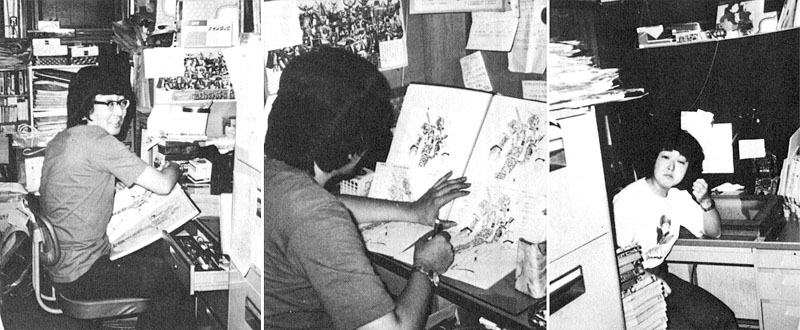
Masao Iizuka and Yoshie Kawahara in the Nippon Sunrise planning office in 1980.
Though Sunrise's remaining founders all retired in 1994, when the company became a Bandai subsidiary, Iizuka remained at his post until he reached compulsory retirement age in 2001.
Ryosuke Takahashi — Atom's Genes, Gundam's Dream Episode 6
Last year, he actually reached mandatory retirement age from Sunrise, becoming the first person to be forced to retire under company regulations. In early autumn of last year, an astonishing number of people from inside and outside the company gathered for his farewell party. There were so many that they couldn't do it in one party, and had to split it into two.
Though Mr. Iizuka wasn't one of the founding members, his love for Sunrise was more founder-ish than the actual founders. Countless people, including not only Sunrise staff but also publishing company editors, freelance writers, and cameramen, have benefited from his mentorship.
But we've gotten ahead of our story. It's time for us to go back to the mid-seventies, when Iizuka and Yamaura were grappling with a new challenge that had been set before them by Soeisha's corporate patron—a challenge that would ultimately result in the creation of 1975's Reideen the Brave.
After a relatively quiet start, 1975 proved to be a big year for the new company. By the end of the year, there were three Soeisha-produced shows on the air simultaneously, and Sunrise Studio's single production site had expanded to three separate studios. Along the way, several major creators joined the company's roster of freelance talent, Yoshikazu Yasuhiko stepped into the spotlight as a rising star of the anime world, and a template was established for the giant robot shows that would become Sunrise's speciality in the following decades.
 勇者ライディーン
勇者ライディーン| TV BROADCAST | |||
| NET • Friday 7:00-7:30 PM April 4, 1975 to March 26, 1976 (50 episodes) |
|||
| MAIN CREDITS | |||
| Planning | Tohokushinsha (ep.1~50) Asatsu (ep.27~50) |
Original story | Yoshitake Suzuki |
| Chief director (チーフディレクター) |
Yoshiyuki Tomino (ep.1~26) | Chief director (総監督) |
Tadao Nagahama (ep.27~50) |
| Music | Akihiro Komori | Character design | Yoshikazu Yasuhiko |
| Producer | Shinichi Miyazaki (NET) | Production manager (制作担当) |
Yasuo Shibue (ep.1~26) Yoshinori Kishimoto (ep.27~50) |
| Production | NET, Tohokushinsha | ||
| ADDITIONAL CREDITS | |||
| Literature manager | Yuu Yamamoto (ep.1~26) | ||
The "Sunrise Anime Super Data File" describes Reideen the Brave as follows:
Guided by a mysterious voice, Akira Hibiki discovers the robot Reideen, a legacy of the Mu Empire which is hidden within a human-faced rock. Akira's mother Lemuria was the daughter of the Mu Empire's ruler. Now the phantom emperor Barao is awakening from a sleep of 12,000 years to usher in an age of demons. With the Earth in peril, Hibiki must Fade In to the Reideen and battle the fossil beasts led by the demonic Prince Sharkin.
In addition to its mysterious story setting and mecha design, the Reideen became popular for its impressive special attack, in which it transformed into a God Bird and rammed into the enemy's weak point. The first half was sharply directed by Yoshiyuki Tomino. In the second half, the torch was passed to Tadao Nagahama, and it took on the style of an epic taiga drama.
Once again, Reideen began with a directive from Banjiro Uemura of Tohokushinsha, Soeisha's corporate patron. Impressed by the merchandising success of Mazinger Z, Uemura instructed Soeisha's managers to create a similar work. With no prior experience in the genre, Eiji Yamaura and his newly recruited deputy Masao Iizuka set to work learning about the strange world of robot anime.
Masao Iizuka & Ryosuke Takahashi — Atom's Genes, Gundam's Dream Episode 6
Takahashi: This is going back a little in the conversation, but earlier you said "They were suddenly told to do giant robots"... So who first told them to do that...?
Iizuka: Mr. Uemura. It was Mr. Banjiro Uemura, the big boss of Tohokushinsha.
Takahashi: Huh?! So it was Mr. Uemura after all?! It feels like that was firmly established as Sunrise's speciality before anyone knew it, but Mr. Banjiro Uemura was the one who brought it up...
Iizuka: Well, if you had your own original work, in those days you'd get 100% of the merchandising, right? Mr. Uemura figured it had worked with 0-Tester.
Masao Iizuka — Gundam-Mono: The Men Who Made Gundam
As we were fretting about what to do next, President Uemura of Tohokushinsha gave Mr. Yamaura the instruction that "Toei Doga is making a lot of money doing Mazinger Z, so you should make a big robot." (laughs) Mr. Yamaura came back and asked me "Iizuka-chan, he told us to make a big robot. What should we do?" We'd never done a giant robot show, so of course we didn't have a clue. We all just groaned and held our heads.
—Although 0-Tester had achieved a certain amount of success, "giant robot shows" were now the mainstream trend in animation. Back then, however, Sunrise didn't have any knowhow about that.
That's right. Mr. Yamaura tried conferring with the members of Studio Nue, watching the Mazinger Z series and Getter Robo (1974), and reading manga, but he still couldn't figure out why giant robot shows were so popular. So I started going to the toy sections of department stores and talking directly with the children there. Nowadays we'd call that market research. I interviewed the kids as we played with the toys, and realized that they were attracted to giant robots because there were certain desires they fulfilled.
Masao Iizuka — Atom's Genes, Gundam's Dream Episode 6
Every Sunday, I'd go to Ikebukuro and walk around Seibu and Mitsukoshi, then I'd go to Odakyu and Keio in Shinjuku. The Seibu in Ikebukuro, and the Matsuzakaya in Ueno, were especially useful. The kids in Shinjuku were classier, so doing research was a bit... (laughs) Every Sunday, I'd go to the department stores and play with the children. Nowadays I'd be considered a creepy, dangerous old man. (laughs)
But little by little, as I listened to what they said and analyzed it, the kids told me "I'm so small," and in those days, "My older brothers and sisters are above me." "There's Mom and Dad, too." Their desire for metamorphosis amounted to "Everyone's bigger and stronger than me, and now I can turn that around." By getting into the robot, the hero "became strong," and then "they beat up the bad guys." That's what I came to understand.
In a process that would become standard for future Sunrise robot shows, the planning began with the development of the main robot. Masao Iizuka discusses this extensively in his Gundam-Mono interview, so I won't go into detail here.
Masao Iizuka — Atom's Genes, Gundam's Dream Episode 6
When we tried thinking about (or analyzing) things like Mazinger Z made by other companies, we asked "What kind of thing is the robot? What's the motif?" and concluded it was "Western armor." So I said to Mr. Yamaura, "If they're doing Western knights, then we should do something new and different if we're aiming for third or fourth place. We grew up watching Toei samurai movies and historical dramas, didn't we? Let's go with the armor of a Japanese samurai general. And they say kids like cool things more than ugly ones, so it should look cool..." But what would be cool? And what then? Et cetera, et cetera. (laughs)
Masao Iizuka — Gundam-Mono: The Men Who Made Gundam
There was one more important setting element that appeared for the first time in the history of giant robot shows, namely transformation. The Reideen transforms into an aircraft form called the "God Bird," but rather than coming from us, that idea was suggested by the sponsor Bandai. They actually built a model and demonstrated it during a meeting. If you lay it down like this and raise the legs, they said, it suddenly becomes an aircraft. Mr. Yamaura and I thought the toymakers were really impressive, and it was truly a revelation.
Up until then, giant robots had never transformed or combined. Well, they did combine in Getter Robo (1974), but there they combined by warping the metal itself, and it wasn't something you could mechanically reproduce. After Reideen, they started making giant robot toys that could transform and combine.
The basic parameters of the robot—a design reminiscent of Japanese armor, a serene face with a humanoid mouth, and a transformation into an eagle-like flight form—were established early in the planning process.
☆ Click the image thumbnails below to see them at full size! ☆
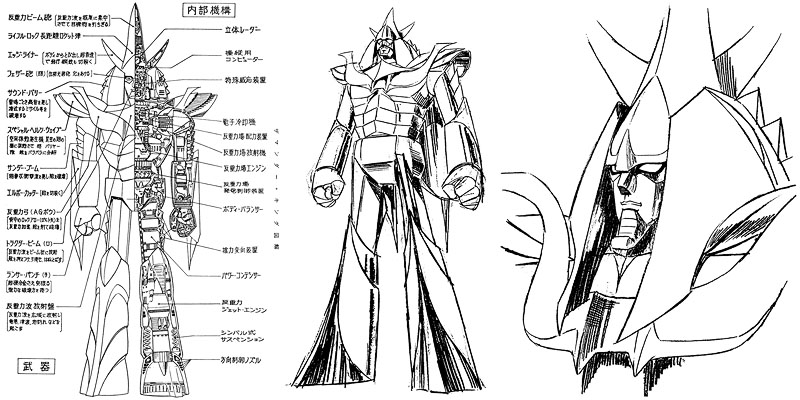
Left: An early diagram of the main robot, labeled with the original working title "Zamander King."
Center: A later draft by Yoshikazu Yasuhiko. Though generally similar to the diagram, it has redesigned "bell-bottom" legs.
Right: A further refinement of the head by Yasuhiko, which now has a chin beard like an Egyptian pharaoh.
The show's intended sponsor was Popy, the Bandai subsidiary which produced the bestselling Chogokin toys. Animator Yoshikazu Yasuhiko worked with Popy designer Katsushi Murakami—and Studio Nue members such as Kazutaka Miyatake—to finalize the robot's design.
Kazutaka Miyatake — Sunrise World Creator Interview 19
During Reideen, we had Mr. (Yoshiyuki) Tomino who directed the first half, Mr. Katsushi Murakami from the sponsor Popy, and Mr. Yoshikazu Yasuhiko the character designer. Since we were starting from scratch, I felt like I could come up with lots of gimmicks and ideas alongside Mr. Yasuhiko.
Yoshikazu Yasuhiko — Motion Picture King Vol.7
—Were you constantly being told "use this mecha" so they could put it out?
Constantly. (laughs) The person in charge back then was Mr. Murakami, who's now the number two or number three at Bandai. He was especially persistent (laughs) and what's worse is that he could draw. So he'd draw things for us, and they were really great. He'd come along and say fiendish things like "I drew this. Do something with it!" (laughs)
Masao Iizuka — Atom's Genes, Gundam's Dream Episode 6
Up until Mazinger Z, the standard was tin toys which waddled along driven by clockwork... So in order to walk, they had to have feet shaped like (oval) bread rolls. It was a big problem that the Reideen couldn't do that. Instead, we gave the bell-bottoms which were all the rage in Japan at the time, and pointy-toed boots with heels... (laughs)
So we released it as a Chogokin. Those were really popular with children, first and foremost because they were so heavy. Previous tin toys felt cheap because they were lightweight, but these seemed like the real thing. That's what the kids would tell us.
As the robot took shape, Yamaura and his collaborators were figuring out the accompanying story. In addition to Yasuhiko and the members of Studio Nue, the scriptwriter Yoshitake Suzuki also played a major role in the planning process.

Prototype character designs from early drafts of the series proposal. The hero, originally named Umito Kurogane, played American football rather than soccer and this was reflected in his combat uniform. School beauty Sayuri Himegai and football club manager Kyoko Onami later became Mari Sakurano and Rei Asuka.
It appears the initial proposal was completed two months into the planning stage. All told, this planning process spanned about six months, from the summer of 1974 to the end of that year.
Nippon Sunrise Planning Office — Roman Album 8: Brave Raideen
In the middle of the summer heat, we spent day and night sweating in a room without working air conditioning, racking our brains in countless planning meetings. We piled up SF and manga magazines, encyclopedias, animal reference books, and so forth, and read them cover to cover, scattering them everywhere, pencils in our hands and cigarettes in our mouths, wiping away the dripping sweat. We argued fiercely, saying this won't do, and that won't do, and not this either. After two months of this, we finally settled on what we were going to do, and in the process we'd produced 400 manuscript pages and 300 pages of drawings. Nonetheless, it still wasn't finished.
Based on this, we sought the opinion of the advertising agency Asatsu, and received ideas, advice, and design support from Mr. Murakami, a designer at the sponsoring toymaker Popy. We rewrote the setting a second, third, and fourth time, revised the designs, and reconsidered the character names. By the time we'd finally managed to complete it, the heat of summer was far behind us and it was now the end of the year.
During those six months, a group averaging about ten people had written well over a thousand manuscript pages, drawn more than 1,200 drawings, smoked 72,000 cigarettes, drunk 5,400 canned soft drinks, and eaten 3,600 bowls of ramen. I'm impressed anew with what a difficult undertaking it was to create our first giant robot story.
Yoshitake Suzuki — Complete Works of Yoshiyuki Tomino 1964-1999
The reason we were doing a robot show was to survive in the anime world. In short, we had to make works even though the rights to preexisting original manga were too expensive for us to buy. So in order to survive, we needed to promote our own original plans. If we made a robot show, at least we could get it on the air and attract sponsors.
At the time, Soeisha was an anonymous little production company with an office upstairs from a coffee shop. It may have had some knowhow about subcontracting, but when it came to producing things itself, it was really inexperienced. This production company was in a situation where they'd finally gotten a plan approved, and they wouldn't survive unless it was successful. So for both Soeisha and myself, it felt like making this robot show was a desperate last-ditch effort.
Along the way, the developing story began to incorporate fashionable "occult" themes such as ESP and ancient lost civilizations.
The World of Tomino Yoshiyuki
The initial plan, titled "Zamander King," envisioned a story about a robot powered by anti-gravity energy in an ocean setting.
The second draft, "Esper Emperor Braver," was reconstructed from scratch to add occult ideas. The setting for main characters such as Akira (initially Jo) Hibiki, Chikara Jinguji, Rei Asuka, Mari Sakurano, and Prince Sharkin (the protagonist's blood brother, according to the originally proposed setting), as well as the mysterious energy Mutron and the concept of "Fade In" (also referred to as "dissolve in" or "body and soul"), were already more or less fixed at this stage.
Masao Iizuka — Gundam-Mono: The Men Who Made Gundam
At that point Mr. Yamaura commented "It seems like the Seven Wonders of the World are pretty popular these days, but what the heck are they?" Back in the mid-seventies, there was a real craze for occult things like pyramid power.
I explained "The Seven Wonders change from one era to the next, but right now, there's a lot of stuff being published in magazines about pyramids, Atlantis, and the lost continent of Mu." He replied "That's it!" So we decided to go with that kind of mystical worldview. This was also reflected in the design of the robot, as the Reideen became a fusion of an armored Japanese warrior and the mask of Egypt's Tutankhamen.
Nippon Sunrise Planning Office — Roman Album 8: Brave Raideen
What we'd come up with was a transforming super robo filled with the kind of occult mystery that was hugely popular at the time. The title changed from "Occult Emperor Braver" to "King of Mystery Reideen," and finally became "Reideen the Brave." The name "Reideen" itself was an English-style twist on "Raiden," who was said to be the strongest sumo wrestler back in the Edo period. We also established that the hero would dissolve into the robot and fuse with it, an idea derived from the world of the occult.
The basis for its uncanny powers was pyramid power. This has become very popular recently, but we were already using it in Reideen. You remember the Reideen was born from a pyramid, don't you? And the interior of that god-faced rock is also a pyramid-shaped space. To give the robot a sense of mystery, we established the setting of the Mu Empire, a mysterious continent that sank to the bottom of the Pacific Ocean long ago, and the Mutron that was its energy source.
Because it was a mysterious robot, the hero who boarded it couldn't be an ordinary Earthling. So we made him a descendant of the Mu Empire, born to the revived daughter of the king of Mu, and destined to unite with this robot. The prayer of this hero who fights for peace is a resounding ("hibiki watari") cry, and the light ("akira") of Mutron, the light of peace, reaches the continent of Mu at the bottom of the Pacific. Thus we gave him the name "Akira Hibiki."
Detail-oriented readers might note an early use of the term "super robo" (スーパーロボ) in this last passage, which was published in 1978. In later years, the "super robot" term would come to be used to distinguish classic giant robot shows from the science-fictional "real robots" of Mobile Sut Gundam and its successors.
The final setting art for the main robot was drawn by animator Yoshikazu Yasuhiko, with the members of Studio Nue contributing secondary elements like attack gimmicks, cockpit interiors, and distinctly organic cutaway diagrams.
☆ Click the image thumbnails below to see them at full size! ☆
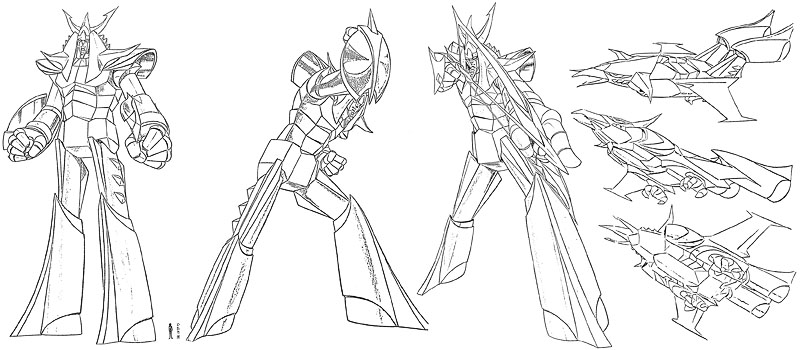
Final Reideen and God Bird setting art by Yoshikazu Yasuhiko.
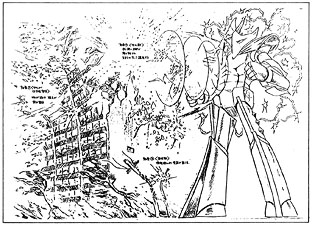
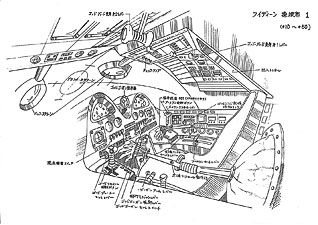
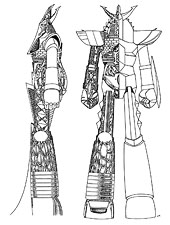
God Voice attack setting, Reideen cockpit, and internal cutaway diagrams by Studio Nue.
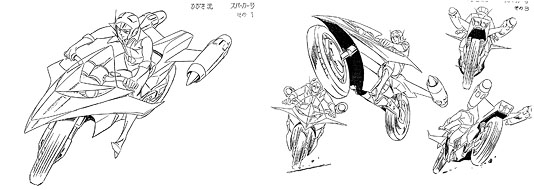
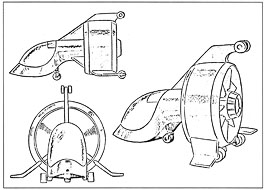
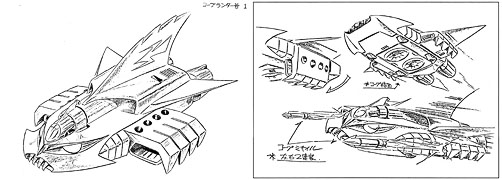
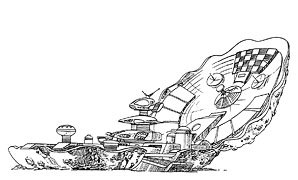
Setting art for Spercar, Spitfighter, Bluegar, and Mutropolis base. Bluegar and Mutropolis were based on ideas by Popy's Katsushi Murakami, and refined for animation by Yasuhiko and Studio Nue.
Not only did Yasuhiko work on the design of the robot, but the series was also his debut as a character designer, and he served as animation director for the first 15 episodes—plus three more later in the series. Meanwhile, Yasuhiko had also been recruited to draw storyboards for Space Battleship Yamato, ultimately handling a total of 13 episodes that aired in the months leading up to Reideen's broadcast debut. Whew!
☆ Click the image thumbnails below to see them at full size! ☆
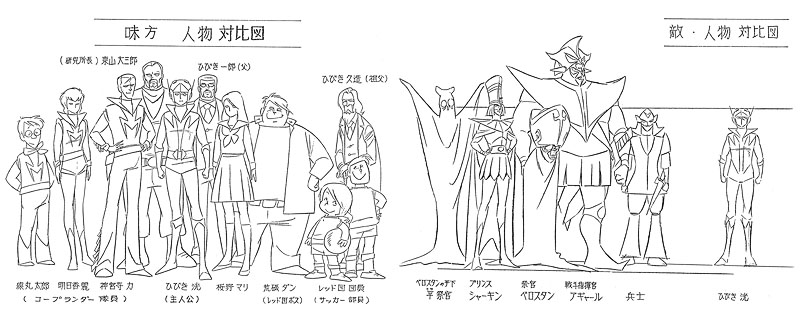
Reideen the Brave character comparison charts by Yoshikazu Yasuhiko.
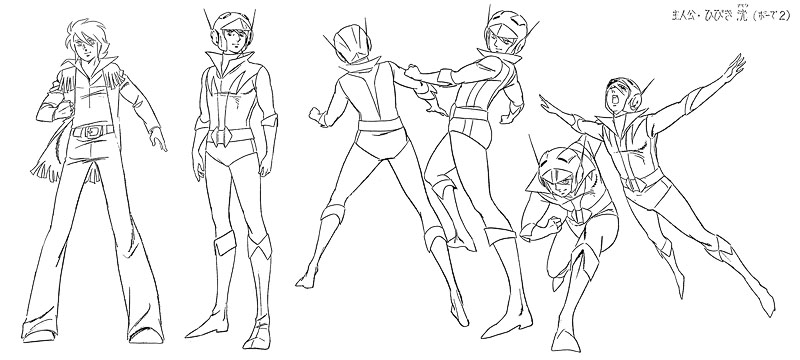
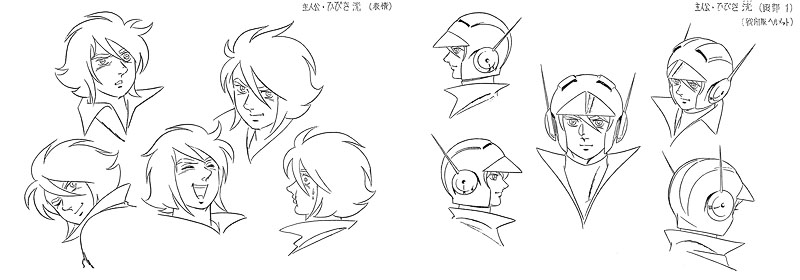
Akira Hibiki character setting art by Yoshikazu Yasuhiko.
Now he was designing his own characters, Yasuhiko had to establish a style that he found aesthetically satisfying. In his "Motion Picture King" interview, he contrasts this with the look of 0-Tester, which was influenced by gritty gekiga comics and the work of Go Nagai.
Yoshikazu Yasuhiko — Motion Picture King Vol.7
With 0-Tester, it was a gekiga-style thing created by a manga artist, and then the designs were revised by an animator named Nakamura. At first, I was disappointed to get lots of revisions. I really don't like gekiga-style things with exaggerated muscles. There's a very strong visceral aspect to drawing, and I can't draw something if I viscerally dislike it. But there's no point in drawing like Atom anymore, and of course Go Nagai's characters were really popular at the time, so we had to do it that way. It's a style that makes you wonder whether Mr. Go might be an interesting person.
I kept thinking how much I hated gekiga, but Mr. Tezuka's style was no good either. So I tried to figure out what kind of style I'd arrive at if it were up to me. Eight heads tall, a little fleshy, with well-defined joints and legs that aren't just sticks... I'd do things like that, and also avoid gekiga-style cheesiness. I was bad at gekiga, and and even worse at gekiga-style anime characters. No matter what, they always feel cheesy to me.
—What did you think when you saw other people drawing your own characters on Reideen the Brave?
I realized that there are lots of people who are better than me. The staff was large, so of course we had some of those, but on the other hand people like that will say "Let me try this." (laughs) Then my own drawings changed little by little, and before long I'd arrived at something that seemed like my own style.
—So rather than drawing the character designs and leaving them as is, you kept using that additional feedback as your own fuel?
If there'd been anything I felt strongly about, I wouldn't have been swayed, but... (laughs) there wasn't. Still, it was different from both the gekiga and Tezuka styles.
Yoshikazu Yasuhiko — Yoshikazu Yasuhiko Design Note
I basically made them by adding my own taste to the lines of 0-Tester, which I was previously working on. At the time I couldn't draw characters with eight-head proportions, so there were endless revisions, and the result was a steady escalation where their legs got longer and longer. I also changed the rejected costume designs and colors countless times, so it was really tough.
The final piece of the puzzle was the selection of Yoshiyuki Tomino as series director. Another Mushi Pro veteran, best known as a storyboard artist and episode director, Tomino had debuted as a series director with 1972's Triton of the Sea.

Left and center left: Yoshiyuki Tomino in 1981 and 1986.
Center right: Tomino in 2002, when he was interviewed for "Atom's Genes, Gundam's Dream."
Right: Tomino around the time of 2019's "The World of Tomino Yoshiyuki" exhibition.
In "Complete Works of Yoshiyuki Tomino," Yasuhiko discusses his previous impression of Tomino as a "wandering storyboarder." Though I've done my own translation of this text, I should credit the Tominostuff blog for bringing this to my attention, and you can see their version for some additional funny anecdotes.
Yoshikazu Yasuhiko — Complete Works of Yoshiyuki Tomino 1964-1999
—When was Mr. Tomino chosen as director of Reideen?
Hmm. It feels like it was at the last minute before we had to make the series, but it was so long ago that I don't really remember.
—From your point of view, what was Director Tomino like back then?
I thought he was a real lightweight. "Wandering storyboarder" also has a lightweight nuance, of someone who'd just turn up wherever you went. So when they decided to have Mr. Tomino direct Reideen, I thought "What, Mr. Tomino? That lightweight?"
I didn't know about Triton of the Sea back then, so I had no idea he'd done a pretty good job with it. I didn't even know he'd done any directing. This is a terrible thing to say, but I had the image of him as some guy who just scribbled storyboards. Just quick sketches.
—If they were scribbles, then how was the quality?
I wouldn't say it was very high.
—Did it seem like he was only doing them to a certain level?
I'd say instead that his storyboards were pretty ridiculous. There were plenty of people who could draw more acceptable storyboards. Storyboards that played it safe, and were basically fine. His storyboards weren't like that, and they'd make you say "Are you taking this seriously?!"
He was fast, and since he was fast he was invaluable, so lots of people would request him. But Mr. Tomino's storyboards weren't well received by animators. There were a lot of cuts that made you say "You must be kidding, what were you thinking?!"
—So it seemed like they'd be hard to put onscreen?
Right. You'd say, why do we have to make a cut like this? I think the situation is still the same today, but TV series are made on a low budget, with about 3,000 frames for twenty-odd minutes. So you'd say this is the bare minimum, we need that movement, this is out of the question unless we do it like that, and so forth until you finally get it down to 3,000 frames. If you start doing extra things, you'll soon end up with 4,000 or 5,000 frames.
In that situation, Mr. Tomino's storyboards were filled with superfluous material, so they were really unpopular with the animators. For example, while a main character was performing in the center of the screen, he'd have an irrelevant passer-by doing something off to the side. Seeing things like that made us furious. "Doesn't he know that doing something like this will take dozens of extra frames?" During animation meetings we'd often cut this stuff out, saying "Nobody's going to notice something like this." Mr. Tomino would probably be angry if he heard that.
—Mr. Tomino came out of the Nihon University College of Art, so he's what you'd call film-oriented. Perhaps that orientation towards film, or rather towards live action, wasn't compatible with the anime industry of the time.
It sure wasn't. Looking back, I think that's true. The storyboards he drew were unsuitable for limited animation. People like that may be drawing their storyboards obsessively in the best sense of the word, but if they're that elaborate and obsessive, people will end up steering clear of them. Their work slows down, and the story becomes tedious.
But Mr. Tomino takes it so lightly that people don't shy away from him that much. Whether he's obsessive or just fooling around, he'll still get your storyboards done in three days. Then afterwards, you just cut out the parts that make you say "What the hell is this?" But he never complains about it. That's just the kind of person he is. That's probably why a lot of people, not just me, thought of him as "Tomino? Oh, that lightweight director."
As the production work progressed, however, Yasuhiko gradually took note of Tomino's enthusiasm for the project.
Yasuhiko
Though I thought this person was a lightweight, his enthusiasm was very unusual. Maybe he was highly motivated, I thought. He certainly seemed motivated, and even though he joined us later on, he was really proactive in saying let's do this and let's do that. It seemed like he wanted to give it his own color.
Based on the dates of planning documents, it seems Tomino had joined the project by December 1974, and series production began in earnest at the start of the new year. The title of the program, though, wasn't finalized until relatively late, and the name and color scheme of the main robot remained undecided as of early 1975. Once again, Masao Iizuka used his unique version of market research to select the colors that subsequently became the standard for Sunrise's giant robots.
Masao Iizuka — Atom's Genes, Gundam's Dream Episode 6
As for the colors... Since it came from the legendary empire of Mu, which sank to the bottom of the sea, we were thinking of green or emerald colors. But these dark colors weren't the hues of righteousness.
When I talked to the kids again, they said "We like red, white, and blue." So I told Mr. Yamaura "Tricolors would be better." "What are tricolors?" "Like the three colors of the French flag..." And then we made the decorations yellow because they were golden. Thus the colors for the Reideen were decided. After we went independent, these went on to become the basic colors of all Sunrise, Inc. robots.
Meanwhile, a contest in the February 1975 issue of TV Magazine—just two months before the show launched—invited readers to vote for the name of the main robot. In addition to "Reideen," the candidates included "Mu-King," "Golder," "Greenger," and "Emerander," the last of these being another of the show's many previous working titles.
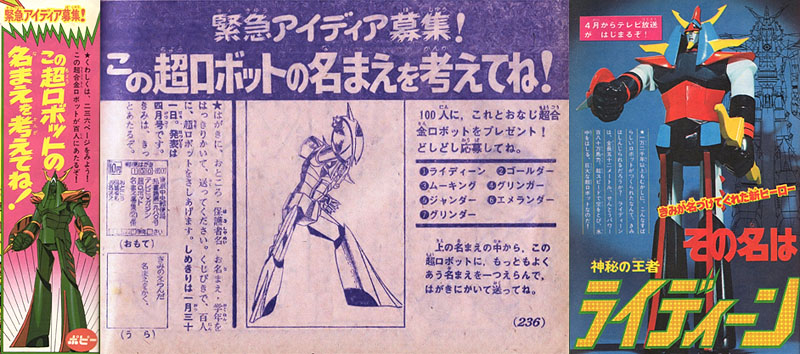
Left and center: Interior pages from the February 1975 issue of TV Magazine, posted to the @sousai_h Twitter account.
Right: Interior page from the March 1975 issue, announcing the title as "King of Mystery Reideen."
With the title finally established as Reideen the Brave, Soeisha's first giant robot show made its broadcast debut on April 4, 1975. Incidentally, this was almost exactly four years before 1979's Mobile Suit Gundam began airing.
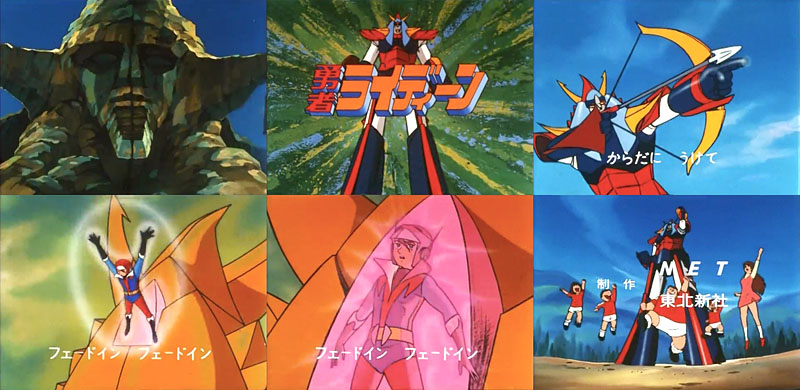
Scenes from Reideen the Brave's opening credits, featuring the famous "Fade In" entry sequence.
However, the series ran into trouble almost immediately. When NET—which would rebrand itself as TV Asahi two years later—was selected as the broadcasting station, their producer objected strongly to Reideen's content, in particular the occult elements which were deemed totally unacceptable. Since the first cours of the show had already been plotted, and the first few episodes already animated, the staff scrambled desperately to change course.
Eiji Yamaura — Atom's Genes, Gundam's Dream Episode 3
We'd already made five episodes of Reideen before the TV station joined in, without hearing the station's opinion. We'd just been making it as we pleased. Then the station producer came in, and told us we had to change everything... He said preschoolers were like this, and the target audience was like that, we couldn't do this and we couldn't do that, and bam bam bam! he'd used his authority to make us go with a preschooler approach. We pushed back, but... he had the power, so we did it.
Yoshiyuki Tomino — Complete Works of Yoshiyuki Tomino 1964-1999
First roughly one cours of story was created, mainly by Mr. Yoshitake Suzuki and Mr. Yamaura of the planning office, and then we started making the film. However, when TV Asahi (then known as NET) was selected as the station, the station producer asked to see the entire first cours of story and then told us "This is no good. It's against our production policy for children's programs."
By that point we already had about three episodes in production, and we were about to start animating the fourth one, but we were told to revise the story anyway. What's more, since they didn't have any confidence in something made by a bunch of youngsters, they demanded we bring in a writer of Masaki Tsuji's caliber. In the end, the storyline from the middle of the first cours through the end of the second was completely rewritten as we were rushing it onto the air.
—Was it the occult elements that TV Asahi objected to?
They told us to remove anything that seemed at all occult. That seemed to be TV Asahi's production policy for all children's programs at the time, including Toei's live-action works. What we were trying to do didn't match their tone, so it wasn't just one producer's opinion. We had to change the entire story, but it ended up taking a whole cours just to adjust it as much as we were able.
By the second cours, we'd finally gotten to the point where we could continue the story along different lines. But they ultimately said the blunders would continue if Tomino was directing, so as we began the second cours, they decided they'd go with Mr. Tadao Nagahama from the third cours onward.
—In the initial proposal, you described it as "a mixture of Devilman, Ultraman, Mazinger Z, etc."
We wanted to make a work that would express children's longing for metamorphosis through something like a robot. We established that it wasn't about piloting. But in fact, at the time, the station had an extremely negative reaction to anything reminiscent of Devilman. The backlash against Devilman must have been pretty bad.
Also, the year before Reideen started, all the stations started featuring a psychic named Uri Geller, and that had actually led to some socially undesirable incidents. So then directives were issued prohibiting any depiction of the occult or psychic powers. TV Asahi had gone so far as to create strict regulations for children's programs, and it was incredibly complicated.
Yoshikazu Yasuhiko — Complete Works of Yoshiyuki Tomino 1964-1999
In some ways, I'm shorter-tempered than Mr. Tomino. If you'll excuse my language, I'd immediately show 'em my ass and say "Don't ask me, you idiot." But he was surprisingly pliable, and he showed a particular tenaciousness at the time. When we got complaints from the TV station, he'd say that we needed more audience service. He'd take already completed film that was about to be delivered, then search through the rush film and splice things in, or tear it all apart and re-edit it. He'd do all of this himself. Personally I thought he should just quit, and I was thinking of quitting myself, so I was a little surprised to see that.
—What did he mean by audience service?
Basically, that we had to raise the energy of the work. So he resolved to do just that. In short, he gathered together things that kids would like and spliced them in, regardless of the story, to make it livelier. It wasn't an "anything goes" level of desperation, but he was doing it with the feeling that this was his job, and he had to do this because it was how he made a living. So he kept the film rolling, and I was kind of surprised when I saw it.
—At the time, there was already another robot series underway at Toei Doga. Weren't you deliberately trying to do something different with Reideen?
I guess it doesn't really matter if you have a lot of similar robot shows, but it's annoying when people say you're copying them, so we made it seem kind of occult. Toei had the assets it had already accumulated, and the name value of Mr. Go Nagai, so it was getting something like a 30 percent audience rating. We couldn't match that no matter what we did, so we already knew who was going to win. But since we were still getting double digits, like 14 or 15 percent, I thought we were putting up a good fight.
So when we were called in to TV Asahi, I went along meekly to Roppongi, expecting that they'd compliment us by saying "You're doing fairly well, aren't you?" But the station director said, and I still remember this, "You're doing this at the Roppongi station, so make something that's worthy of it." I was furious, and I wanted to say "How dare you say that to us?!" The staff had never made anything like a robot anime before, so we were working under terrible conditions. And as I said before, Mr. Tomino's storyboards were also really exhausting. (laughs) As an animation director, I'd been trying my best to keep everything together, but after hearing something like that I told Mr. Tomino I was thinking of quitting.
When I told him this, Mr. Tomino replied "No, you shouldn't do that." My impression of him at the time was that he was a very tenacious person. He'd been re-editing things that were already virtually finished. In a way, I thought in that moment that he was a real adult. The previous lightweight Tomino was gone. I realized that he really cared about Reideen, and that this was someone really persistent. Those two things are the impressions that stuck with me about Mr. Tomino on Reideen.
Despite Tomino's efforts, he was forced to step down as director, taking the blame for the TV station's complaints. Veteran director Tadao Nagahama, who was well-regarded for his work on the long-running "Star of the Giants" (1968 to 1971), replaced him as series director as of episode 27.
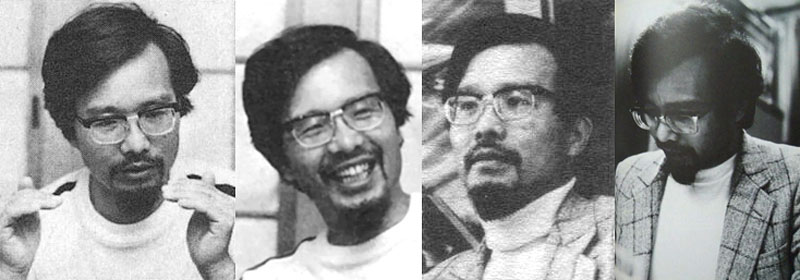
Tadao Nagahama prior to his sudden death in 1980.
To the surprise of many of his colleagues, rather than leaving the production entirely, Tomino continued working on Reideen under the new leadership. He ultimately storyboarded four episodes—including the series finale—under his "Minoru Yokitani" alias.
Yoshiyuki Tomino — Complete Works of Yoshiyuki Tomino 1964-1999
When I handed over the job, I only talked with Mr. Nagahama for ten or fifteen minutes. Maybe this is just the nature that Sunrise had established by that point, but in the moment they replaced the chief director, the entire structure changed as well, and I didn't have any role. So I didn't feel like watching it, and I don't know what happened.
Haruka Takachiho — Atom's Genes, Gundam's Dream Episode 10
It was a different time, and Mr. Tomino's success wasn't yet in sight during Reideen. Whatever was really going on behind the scenes, he stepped down halfway through. What I thought was amazing at the time was that normally, when that happened, you'd stop working on the series, or at least go somewhere else. But he ended up sticking with Reideen as an ordinary episode director. I think that shows an unusual strength of will.
Yoshikazu Yasuhiko — Complete Works of Yoshiyuki Tomino 1964-1999
Another thing that made an impression was when they changed director after the second cours, episode 26, of Reideen. They said "Tomino was wrong for this after all" and called in Mr. Tadao Nagahama, a proven hit-maker. I stayed on as animation director, but from then on Mr. Tomino became an ordinary episode director.
Normally it would be better to just leave, and it must have been unpleasant. But he said he wanted to see Mr. Nagahama's techniques so he could learn from them, so he became an ordinary episode director under Director Nagahama. I was pretty surprised since this was effectively a demotion. If it were me, I think I'd have said "Screw you!" and gone someplace else.
—So he voluntarily became an ordinary episode director?
Replacing him was the company's decision. The pretext was that the ratings were still lackluster, and they needed to make it more entertaining.
Speaking of Director Nagahama in those days, this is a trend I started seeing around the time of 0-Tester, but people who were like forerunners of anime otaku started visiting the studio. Reideen also attracted these weird young adult fans. It wasn't Mr. Nagahama who'd made it popular, and even before that it was a time when this kind of minor anime was drawing fans, like a presentiment of the anime boom. High-schoolers and college students were sending us letters and making fanzines, and I recall we were a little perplexed to see them.
—You didn't look on this favorably?
Not at all. "What are you thinking, you're too old for this," we said. Mr. Tomino said the same thing. But Mr. Nagahama was someone who cherished those kinds of fans, and they followed him around like a royal guard.
Though the early part of the series had earned a loyal following among older viewers, this wasn't necessarily what the TV station or the toymaker sponsors were looking for. Under Nagahama's leadership, Reideen completed its transformation into a story aimed at younger viewers. Despite the rocky start, and the mid-series drama surrounding the change of directors, it succeeded in laying the foundation for the Sunrise era to come.
Masao Iizuka — Gundam-Mono: The Men Who Made Gundam
Reideen had setting elements such as a mystical worldview and complex personal relationships which weren't found in previous giant robot shows. That made it more interesting on the creators' side. But since we were all middle-aged guys in our thirties, if we just made it the way we found most interesting, it would be difficult for the kids who were our main audience to understand. And then we'd be deviating from our objective of getting them to buy robot toys and picture books.
Middle- and high-school fans were delighted, and they started sending us fan letters and coming to hang out at the Sunrise studio, but the hard reality was that we'd go out of business if we couldn't get the ratings. That hit us like a sudden blow to the head. So after that, Sunrise struggled through a lot of trial and error. We made a show called Robokko Beeton (1976) aimed purely at children, which was like a cross between Obake no Q-Taro and Doraemon.
Ultimately, due to the opinions of the broadcasting station and the advertising agency, the decision was made to replace the producer and director in mid-series. The content also underwent various changes. It turned out that kids only wanted to watch scenes of the robot in action. So we'd show them a battle even in the first half of the program, with Reideen at a disadvantage. Then we'd construct each episode so that it turns the tables and settles things in the second half. Since that alone would get repetitive, we also created setting where the combat scene in the first half would be a battle among the enemy side to determine who'd get to challenge Reideen that week, and then the winner would fight Reideen.
—Was this kind of divergence between what you wanted to make, and what you ought to make, the result of a difference in opinion between the planners and the production site? Or were the planning and production sides equally susceptible?
Even with an original work, the story's starting point and an outline of its eventual conclusion are roughly envisaged at the beginning, during the planning stage. But just as the content of serialized manga can change based on surveys and so forth to match the trends of reader desires, TV animation often has to be shored up after it's already on the air, because it's too far ahead of or behind the times, or it doesn't match the trends among viewers and sponsors. The result was that the first half of Reideen was popular with middle- and high-schoolers, while the latter half was poorly received by them but popular with little kids.
 ラ・セーヌの星
ラ・セーヌの星| TV BROADCAST | |||
| Fuji TV • Friday 7:00-7:30 PM April 4, 1975 to December 26, 1975 (39 episodes) |
|||
| MAIN CREDITS | |||
| Planning | Unimax | Original story | MK (Mitsuru Kaneko) |
| Chief director (チーフディレクター) |
Masaaki Osumi (ep.1~26) | Chief director (総監督) |
Masaaki Osumi (ep.27~39) |
| Music | Shunsuke Kikuchi | Producer | Takaharu Bessho Ryosuke Nakamura Eiichi Kubota (Fuji TV) Masami Iwasaki |
| Production | Fuji TV | ||
| ADDITIONAL CREDITS | |||
| Character design | Akio Sugino | Production manager (制作主任) |
Tohru Komori |
| Assistant chief director (チーフディレクター補佐) |
Satoshi Dezaki (ep.1~26) | Director (監督) |
Yoshiyuki Tomino (ep.27~39) |
On the same day as Reideen's broadcast debut, another Soeisha production began airing on the Fuji TV network. This was Star of La Seine, a historical action series in which a masked heroine battles corrupt aristocrats in pre-revolutionary France. The "Sunrise Anime Super Data File" describes it as follows:
It is the eve of the French Revolution. The citizens are oppressed by the aristocrats, who fear a revolt. A mysterious girl known as the Star of La Seine, who always leaves behind a bright red carnation, protects the common people from the aristocrats. Her true identity is Simone, who sells blossoms in the flower market.
This anime for girls aimed to follow in the footsteps of The Rose of Versailles and Princess Knight. Simone is established as Marie Antoinette's younger sister, and when she learns the truth in the middle of the story, she is placed in an agonizing position in this historical taiga drama.
Unlike 0-Tester and Reideen, which had been developed from scratch by Soeisha, Star of La Seine was brought to them by an outside company. A second production site, which became Sunrise Studio 2, was hastily set up atop the nearby Koyo Building to handle the new project.
Soon afterwards, Soeisha was tasked with the production of a third series, which we'll discuss below, and Sunrise Studio 3 was established on the second floor above a grocery store.
Yoshie Kawahara — Great Mechanics G, 2015 Autumn
Even now, a five-story blue building still stands diagonally across from Kami-Igusa Station. This is the Koyo Building, a building owned by a real-estate company which seems to have somehow been linked by fate to the "Sunrise" name. In 1975, the Star of La Seine production studio was established on its fourth floor. Up until 1978, this location was known as Studio 2. Its floor space was about half to two-thirds that of Studio 1. The fifth floor was even more cramped, and from this time it became the "head office" where the president and the accounting staff had their desks.
Masao Iizuka & Ryosuke Takahashi — Atom's Genes, Gundam's Dream Episode 6
Iizuka: Around November of the year Reideen the Brave was decided, Mr. Mitsuru Kaneko of MK, who was previously a producer at Fuji TV, came to us with a plan. At the time, everything we did was with Fuji TV and Kansai TV. Soeisha was on the Fuji TV network. Mr. Shibue became the producer on Reideen the Brave, and Mr. Iwasaki said "Please help him out for a little while, Iizuka-chan"...
Takahashi: What was the plan that Mr. Kaneko brought to you?
Iizuka: That was Star of La Seine. Then Iwa-chan started human trafficking (gathering staff). (laughs) He asked Nakagawa-chan (Hironori Nakagawa, currently Sunrise's Chief of General Affairs), who was previously in sales at Mushi Pro, to be a production assistant, followed by Mr. Yutaka Kanda and then two complete newcomers. But they still didn't have a production manager, so he recruited Mr. Komori... During the final days of Mushi Pro, Mr. Komori had often come in as a subcontractor, so Iwa-chan knew him well and trusted him.
But this time we didn't have anywhere to use as a studio, so we chose the fifth floor of the newly constructed Koyo Building. Even the president didn't have a desk at that point. (laughs) At first, nobody had a desk, not even any of the managers...
Takahashi: So you moved from a place over Yutaka to the fifth floor of the Koyo Building.
Iizuka: Right, the fifth floor. It had the lowest rent because it was so small... (laughs) But it was too cramped, so then we rented the fourth floor, which was the next cheapest. (laughs) That's where we made Star of La Seine. Reideen the Brave was on the second floor of Yutaka.
Takahashi: So there were only those two.
Iizuka: Right, right. But then Mr. Yasuhiko's Kum Kum was decided right afterwards, so we rented the cramped second floor of a grocery, which was then called "Yaoshō" and is now "Books Bunyu." The producer was Mr. Shiba (Tatsuo Shibayama).
Yikes! We didn't have any space, we didn't have any people, and what's more all our shows were airing on the same day at the same time. That year was a complete mess.
As Iizuka notes, Reideen and Star of La Seine were broadcast in the same time slot—7:00 to 7:30 PM Fridays—on different networks, making the two shows direct competitors. And the situation was only going to get worse.
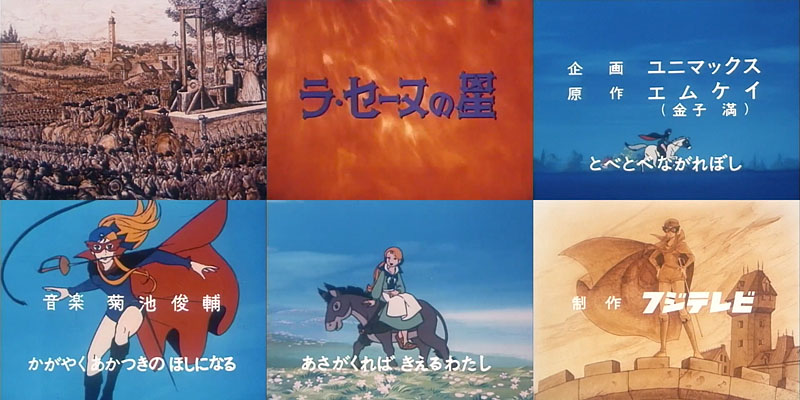
Scenes from Star of La Seine's opening credits.
As the series entered its third and final cours, Yoshiyuki Tomino—recently ejected from Reideen—was brought in to replace Satoshi Dezaki as director.
Yoshiyuki Tomino — Complete Works of Yoshiyuki Tomino 1964-1999
After I was removed from Reideen, I had to go back to being a freelance storyboard artist. Then a completely different problem arose on Star of La Seine, and they called me in to somehow wrap everything up.
—They wanted you to make something like a Soeisha-style Rose of Versailles.
I'm sure they did. They were finishing up the production of the second cours, and still had to do a third one. But they didn't have a series director on site, which is essential. I did the job in a really crude way, too.
With TV, each episode is a one-time thing, so I had a terrible time. If you don't know what happened in the previous episode, you can't understand the situation. I didn't even try to figure that out, I just storyboarded the scripts I had, and because I had to do something about the last few episodes I did them all together. That's all there was to it, and I didn't think about it at all. It was purely a final cleanup, and in terms of directorial approach, I just did it all based on technical principles.
 わんぱく大昔クムクム
わんぱく大昔クムクム| TV BROADCAST | |||
| TBS • Friday 7:00-7:30 PM October 3, 1975 to March 26, 1976 (26 episodes) |
|||
| MAIN CREDITS | |||
| Planning | ITC Japan | Original story | Yoshikazu Yasuhiko |
| Production | MBS, ITC Japan | ||
| ADDITIONAL CREDITS | |||
| Literature manager | Tadashi Akiyama | Character design | Yoshikazu Yasuhiko |
| Art | Kazunari Ban | Assistant director | Kenjiro Yoshida |
| Music | Masahiro Uno | Production manager (デスク) |
Yuichi Yoshioka |
| Setting manager | Kazuichi Tsurumi | Producer | Tatsuo Shibayama |
| Assistant producer | Tohru Komori | Director (演出) |
Rintaro |
Six months later, a third Soeisha production launched on the TBS network. The "Sunrise Anime Super Data File" describes Kum Kum as follows:
Long, long ago, when primitive humans and dinosaurs still lived together in harmony, there was a prehistoric village at the foot of a tall, tall mountain range. Here, a boy named Kum Kum and his family lived happily with the pleasant people of their village and the very gentle dinosaur Saurus. But it looks like naughty Kum Kum is going to cause some kind of commotion again today...
Yoshikazu Yasuhiko was responsible for planning, original story, character design, animation direction, episode direction, and even some of the scriptwriting. He made this a kind and heartwarming story revolving around the love of family in a prehistoric setting. Every corner of the screen is suffused with Yasuhiko's colors, and this may be the work that first created wide awareness of his sensibilities. At the start of broadcast, the title was simply "Kum Kum," but from episode 7 onwards it became "Wanpaku Omukashi Kum Kum."
Created by the multitalented Yoshikazu Yasuhiko, this gentle story about the adventures of a prehistoric boy began as a whimsical pitch that drew the attention of the confectioner Glico, best known for its Pocky snacks.
Yoshikazu Yasuhiko — Yoshikazu Yasuhiko Design Note
This was my own plan, so I thought it would be nice to make a heartwarming story featuring little kids. I guess my attention had turned to cute little kids due to the shock of seeing Heidi, and the fact that I'd just had a child. I think it was a good thing that when I was creating the characters, the director Mr. Rintaro told me to set aside the stylish lines I'd learned when I was working at Mushi Pro.
Yoshikazu Yasuhiko — Motion Picture King Vol.7
That was also around the time of Reideen. Even though I was earning a living from 0-Tester, I was saying things like "Robot anime is so boring," so they asked me "Then what would be interesting? Show us!" When I did just that, it caught Glico's eye, and for the first and last time in my life I suddenly found myself getting a primetime slot.
—I hear you modeled the protagonist on your first-born son.
Right. My son had just been born, so I wanted to do something heartwarming that would appeal to little kids. Not something with hacking and slashing. That also shows you I'm a naturally heartwarming person. (laughs)
Yoshikazu Yasuhiko — Yoshikazu Yasuhiko Art Collection
Kum Kum was sponsored by a major confectioner. One of its products was a lickable chocolate on a stick, and Kum Kum was meant to be used as a character for that. Since it was lickable, it had to be so cute you couldn't help but want to lick it, so they gave me a lot of orders about this and that.
Ultimately I ended up in a conference room at the Dentsu Building, where I felt completely out of place, being stared at by important-looking people in business suits. I was literally dripping with sweat as they fussed about various things, and then finally gave me the OK. I think the exhaustion I felt afterwards, walking home through the back alleys of Ginza at dusk, still lingers somewhere in my body.
Yasuhiko's adorable character designs also reflected his perspective as a new father. His first son had been born in 1972, while he was still working at Mushi Pro.
☆ Click the image thumbnails below to see them at full size! ☆
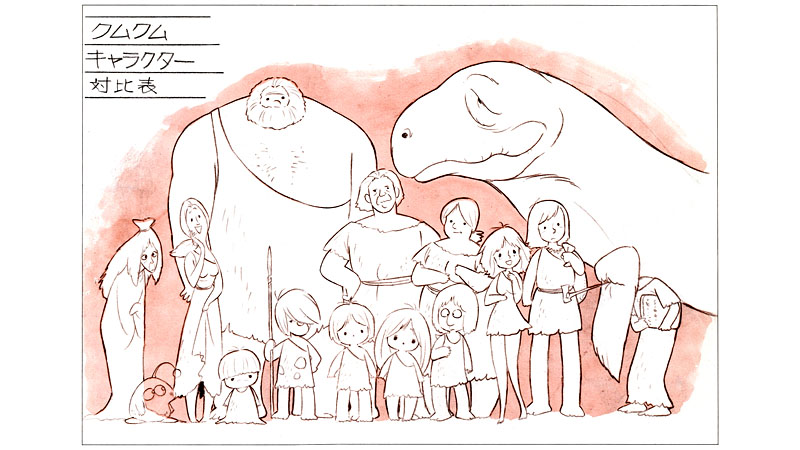
Kum Kum character comparison chart by Yoshikazu Yasuhiko.
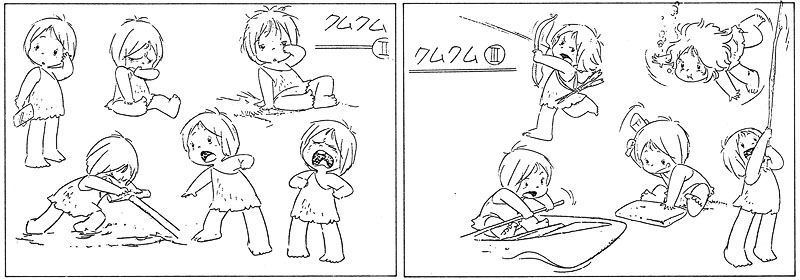
Kum Kum character setting art by Yoshikazu Yasuhiko.
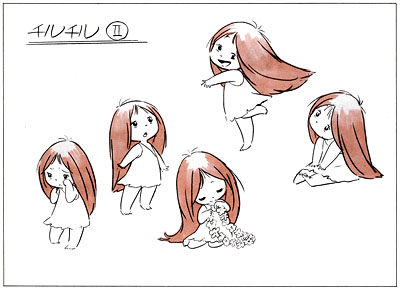
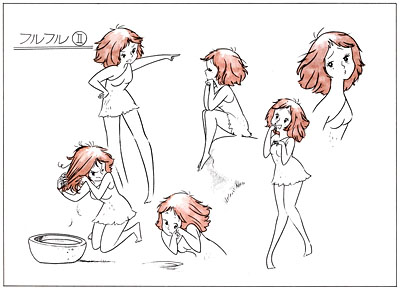
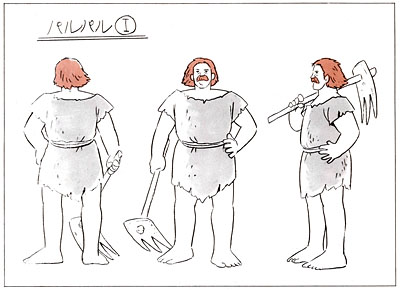
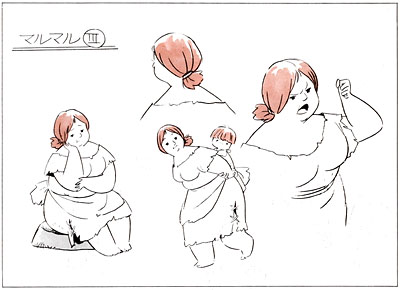
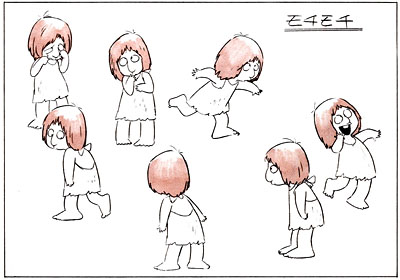
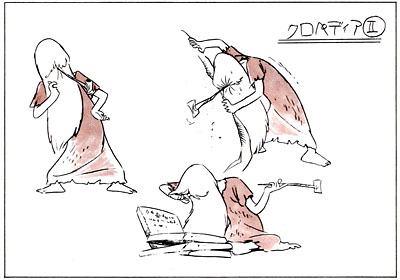
Character setting art for Kum Kum's family and neighbors by Yoshikazu Yasuhiko.
Once Glico had approved the proposal and agreed to sponsor the show, Rintaro, a veteran Mushi Pro director and a co-founder of the Madhouse studio, was hired to direct it. A new Sunrise Studio production site, which became known as Studio 3, was established to handle the additional workload.
Yoshikazu Yasuhiko — Yoshikazu Yasuhiko Art Collection
On Kum Kum, they initially asked me to direct it. I'd only been working for about three years, and I didn't know anything about directing at the time, so I thought "You must be kidding." But when I looked at the producer, Mr. Tatsuo Shibayama, his face was uncharacteristically serious as he said this. So I realized I was in big trouble, and I was really worried that I'd somehow have to brace myself to do it.
But in the end, there was no need. It seems that, after all, there were complaints about "a rookie like that..." They eventually chose the far more experienced Mr. Rintaro as director. I was really grateful.
Yoshikazu Yasuhiko — Motion Picture King Vol.7
They called in Mr. Rintaro as series director, and it felt strange having Mr. Rintaro direct something based on my own original work. At the time, he told me "This will never happen to you again. If you think this sort of thing comes along every day, you're deeply mistaken." (laughs) And he was absolutely right.
—Was it pretty difficult arriving at the final drafts of the characters?
Mr. Rin is very clever, and he tried to completely eliminate my color from it. (laughs) He was really impressive in that respect. He called in a staff he'd trained himself. But in the end, Mr. Rin gave me some recognition, and he decided to have me script and storyboard the final episode. I just happened to hear this at the time, but Mr. Rin said "These are really good storyboards, so follow them exactly." I was deeply moved, and I thought "I won!" (laughs)
At the beginning, he said "Mr. Yasuhiko is a drag" and he kept me at quite a distance. (laughs) But as it happened, I was pretty busy since I was also working on Reideen, so that was for the best.
—When Kum Kum ended, did Reideen replace it?
That's also a sad story. Soeisha started out as a company doing a single work, 0-Tester, but now it was responsible for three at once. The other one was Star of La Seine, and what's more, all of them were in the same time slot at 7:00 PM on Friday. (laughs) It was a laughing stock within the industry.
And indeed, from Kum Kum's debut in October 1975 to Star of La Seine's conclusion at the end of December, the company was responsible for three simultaneously airing TV series—all of them running in the exact same time slot.
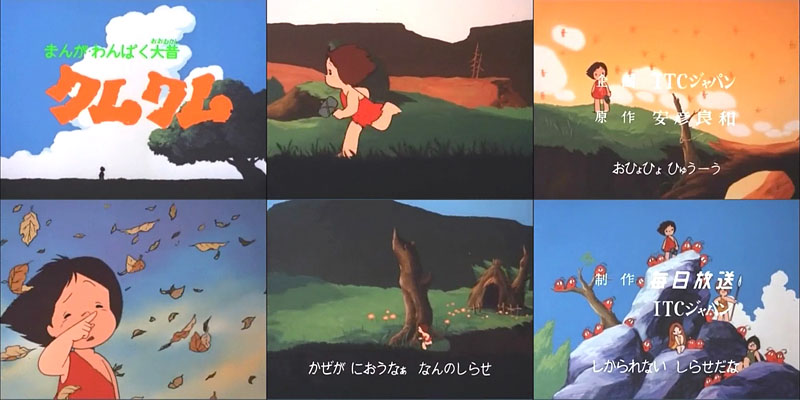
Scenes from Kum Kum's opening credits. As of episode 7, the prefix "Wanpaku Omukashi" (Naughty Long-Ago) was added to the title.
Before we move on, I'll share one more anecdote from Ryosuke Takahashi's "Atom's Genes, Gundam's Dream" series. Here's how Takahashi describes Kum Kum producer Tatsuo Shibayama...
Ryosuke Takahashi — Atom's Genes, Gundam's Dream Episode 6
I shouldn't say this, but of everyone I know, he's the one I'd describe with the classic phrase "drinking, gambling, and women." I learned a lot from him, too. He successively produced Dororo, Little Wansa, Space Battleship Yamato, Kum Kum, and so forth, but while Kum Kum was airing, he was jailed for a traffic violation (in a general jail, because the traffic jail was full). I recall Sunrise tried desperately to keep that a secret from everyone.
As his self-proclaimed henchman, I went to meet him when he was released from the Hachioji jail. I went there hoping to see a scene of Mr. Shiba at the iron gate with all his belongings in a bundle, bowing deeply to his guard and saying "Thank you for everything." But it was nothing like that, and I was heartbroken when a cheerful Mr. Shiba emerged with a "Hey there!" from the glass door of a hospital-like entrance, looking plump and healthy. (Living a hygenic and regular life without cigarettes and alcohol, he'd actually gained about ten kilos.)
Compared to the dramatic developments of the previous year, and their upcoming rebirth as an independent company, 1976 seems in hindsight like a relatively unremarkable year for Soeisha and Sunrise Studio. The most memorable work from this period was Super Electromagnetic Robo Com-Battler V, a subcontracted job for Toei which launched a series of robot shows helmed by Reideen's replacement director Tadao Nagahama.
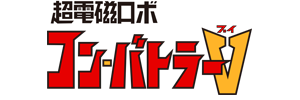 超電磁ロボ コン・バトラーV
超電磁ロボ コン・バトラーV| TV BROADCAST | |||
| NET • Saturday 6:00-6:30 PM April 17, 1976 to May 28, 1977 (54 episodes) |
|||
| MAIN CREDITS | |||
| Planning | Kanetake Ochiai (NET) Takashi Iijima |
Original story | Saburo Yatsude |
| Music | Hiroshi Tsutsui | Original character design | Makiho Narita |
| Mechanic setting | Studio Nue | Animation character design | Yoshikazu Yasuhiko |
| Chief director (総監督) |
Tadao Nagahama | Production cooperation | Tohokushinsha Soeisha |
| Production | NET (TV Asahi), Toei, Toei Advertising | ||
| ADDITIONAL CREDITS | |||
| Art | Takashi Miyano | Setting assistant | Osamu Kobayashi |
| Animation manager (作画制作) |
Tadashi Yahata | Production manager (制作担当) |
Masami Iwasaki Yoshihiro Nozaki |
Launched a few weeks after the end of Reideen the Brave, in a different time slot on the same network, and with many of the same staff—including series director Tadao Nagahama and character designer Yoshikazu Yasuhiko—the giant robot series Com-Battler V was widely perceived as Reideen's spiritual successor. The "Sunrise Anime Super Data File" describes it as follows:
The Campbellians who have been sleeping deep underground have revived. Led by their great general Garuda, their servant beasts begin an invasion of the Earth. Anticipating this threat, the Nanbara Connection develops five combat mecha and entrusts them to five youngsters. When their brainwaves are synchronized, the five mecha will combine to form the super electromagnetic robo Com-Battler V.
Following in the tradition of Reideen the Brave's enemy leader Sharkin, the tragic Garuda created a "beautiful character" boom, which then led to Heinel in Voltes. This was also remarkable for the first toy that combined just like in the anime.
While Reideen had been planned by Soeisha at the direction of Tohokushinsha, Com-Battler V was conceived by the television division of Toei. (The original story is credited to "Saburo Yatsude," a collective pen name for Toei's TV producers similar to the "Hajime Yatate" pseudonym later adopted at Sunrise.) Its production was entrusted to Takashi Iijima, a longtime producer at Toei's animation subsidiary Toei Doga, who had recently been transferred to the main company to guide the development of its own original anime.
Takashi Iijima — Roman Album 16: Combattler V
At first, I thought it would be simple.
The sponsor wanted to make a giant robot show. The idea was that we'd have five machines combine into a giant robot, changing their original shapes as little as possible. Fortunately, there was a madman or genius (and I mean that as a compliment) on the sponsor side named Mr. Murakami, who'd already completed the toy concept.
As with Reideen, the new series was to be sponsored by Bandai's Popy subsidiary, and the basic design of the robot was conceived by Popy's Katsushi Murakami. An early draft of the series proposal—originated by Osamu Tezuka himself, according to the "Roman Robo Anime Climax Selection"—featured a six-part combining robot and the working title "Roboider 6."
☆ Click the image thumbnails below to see them at full size! ☆
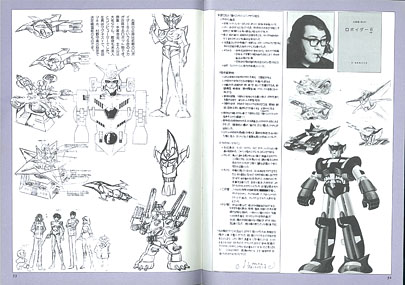
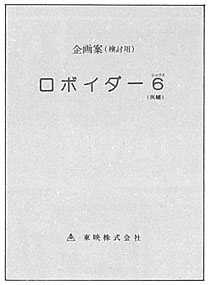
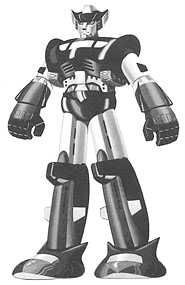
Left: Pages from Roman Robo Anime Climax Selection, as posted on Pinterest.
Center: Cover page of "Roboider 6" proposal from Roman Robo Anime Climax Selection.
Right: Roboider 6 robot design from Roman Robo Anime Climax Selection.
Iijima also recruited novelist and scriptwriter Masaki Tsuji, who had been brought in to assist early in Reideen's broadcast run, to help develop the story.
Masaki Tsuji — Roman Album 16: Combattler V
Though Producer Iijima was of course an old acquaintance, we actually hadn't seen each other for a while. That's because he'd been transferred from Toei Doga to the main company, so he no longer had anything to do with writers like me who specialized in anime (though if they invite me over, I'll come running anywhere, rubbing my hands.)
Then one day, Mr. Iijima said "I'm doing an anime, so please join me."
I was confused. "You've gone back back to Doga?"
"No, now we're doing anime at the main company too."
"If you're doing that, then where's the staff?"
"The staff is... just me."
"Huh?"
I was dumbfounded, but I heard him out, and he explained that the staff would be entirely outsourced.
"I wonder if you'll be able to find outstanding staffers..." Setting aside my own situation, I was worried about the directors and animators.
"Reideen the Brave is really good. I'd love to get that staff."
So Mr. Iijima said, but we didn't know whether Sunrise's top talents would be willing to work on something they'd be so perfect for.
Though Iijima was eager to recruit director Tadao Nagahama and his Reideen team to work on Com-Battler V, it wasn't until the very last minute that Nagahama accepted the job. In his "Roman Robo Anime Climax Selection" essay, Nagahama confesses that he'd been deliberately stalling Iijima while he tried to arrange a direct followup to Reideen.
Tadao Nagahama — Roman Robo Anime Climax Selection
When the end of Reideen the Brave's broadcast run was all but certain, those of us on the Reideen team really wanted to somehow continue the program, and we came up with a plan for a "Reideen sequel."
—After the fighting is over, the Reideen is serving as a relay station for the peaceful use of Mutron energy. Then a new enemy from the phantom empire appears. But the Reideen won't move... is it all over?! Suddenly, a new Reideen shows up! And riding in it is Akira's younger brother!—
I think it was a story like that. However, the station's response to this plan was slow in coming. As we waited impatiently, an entirely different plan came our way from somewhere else. This was Com-Battler V. If "New Reideen" wasn't going to happen, we wanted to take this on, but since we hadn't heard back about "New Reideen" we couldn't give them a reply about Com-Battler either.
I can put this in print now, but at the time, I was really struggling with the constant pressure from Mr. Iijima. So I used the tactic of saying "The person in charge is on a business trip, and they haven't come back yet." Meanwhile, we continued working on "New Reideen" as much as possible. But we couldn't keep waiting forever. Just as it was about to become impossible to start the new program, we finally gave up on the "Reideen sequel" and decided to take on Com-Battler V.
Tadao Nagahama — Roman Album 16: Com-Battler V
In my career as a director, it feels like I've never had so much trouble at the start of a program. We received the original plan only three months before it went on the air, so at a point in time when we should already have begun animating, we were only just starting out by fundamentally revising the plan.
Upon joining the project, Nagahama immediately set to work on revising and completing the series proposal. Since the earlier "Roboider 6," this had been refined into a new draft titled "Magness V," featuring a five-part combining robot and a team of heroes reminiscent of 1972's Science Ninja Team Gatchaman.
☆ Click the image thumbnails below to see them at full size! ☆
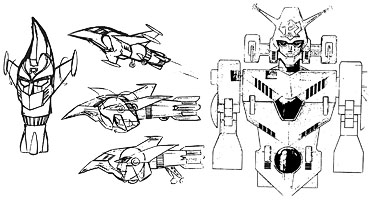
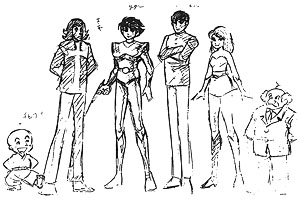
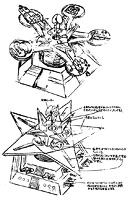
Rough designs for mecha, character, and base created for "Magness V" proposal. In the Roman Robo Anime Climax Selection, this artwork is credited to Makiho Narita and Moribi Murano, but the illustration of the robot's upper body is actually by Popy's Katsushi Murakami.
Dissatisfied with the robot and character designs, Nagahama requested the services of the increasingly popular—and busy—Yoshikazu Yasuhiko, who had played a vital role in the success of Reideen and was currently hard at work on Kum Kum.
Tadao Nagahama — Roman Robo Anime Climax Selection
We certainly had a great idea for a toy, in which five mecha combined into a single robot, but we hadn't figured out how we were going to use that in a drama. We had no idea at all of the robot's features, the character setting wasn't appealing, and we didn't have a clear notion of why the five initially scattered heroes came together or why they combined. And the biggest shock was the drawings of the characters. An ugly robot, and old-fashioned manga-style characters... we'd never be able to win the hearts of the viewers with those.
At the time, I always invited naughty kids from the neighborhood to the Reideen preview screenings. One day, on the way back from the preview, they happened to see some Com-Battler setting on my desk. "What the heck's that?! Hey, pops, why're you making something this terrible?"
They had keen eyes. I always observed them as they watched the previews, reconsidering the parts that made them yawn and smiling when I saw their eyes sparkling. When they spoke this clearly, there was no doubt. If we went ahead like this, the program would be a failure. Needless to say, I started searching desperately for a way to save the program. Above all, the characters had to look cool if I was going to have confidence in them, so I hastily begged for Mr. Yasuhiko's help. And he did a magnificent job!
As on Reideen, though the sponsoring toymaker was heavily involved in the initial design of the robot and the Studio Nue team worked on the detailed setting, Yasuhiko was responsible for adapting it for animation. This practice of treating the robot and main mecha as part of the character design was fairly standard before the advent of specialized mechanical designers like Kunio Okawara.
☆ Click the image thumbnails below to see them at full size! ☆
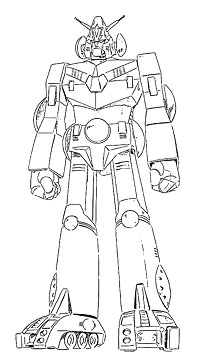
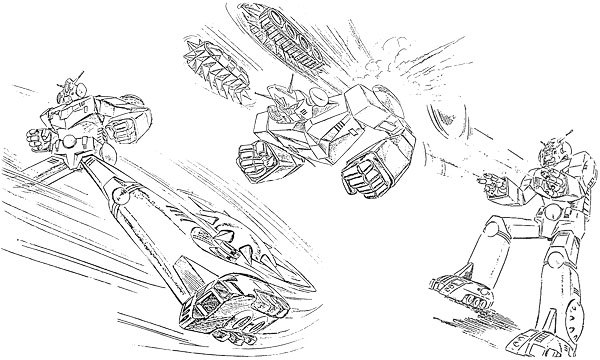
Setting art for Com-Battler V robot. Basic setting by Yoshikazu Yasuhiko, special attack and weapon details by Studio Nue.
Next, functional roles were given to the robot's five component mecha, and the personalities of their pilots determined accordingly. Nagahama goes into considerable detail about this in his Roman Robo Anime Climax Selection essay.
Tadao Nagahama — Roman Robo Anime Climax Selection
Instead of the usual single protagonist, we had five people, and we couldn't get a handle on them. The setting was that they couldn't combine unless their feelings were synchronized, which was fine. But if we made that the focal point of the drama, we'd end up with a recurring formula where every time we asked "So will they be able to combine today or not?!" and people would give up immediately.
From the toy company's point of view, if there are five times as many mecha then you can expect to sell five times as many toys. But from the dramatist's perspective, the more mecha you have, the greater the possibility of failure. In that situation, we wistfully recalled the simple structure of Reideen.
Ultimately, I decided to divide them up by giving each of the five mecha a distinctive function, and then connecting that to the personality of the character piloting it.
Thus, when they were separated, they could each fight in a way that made use of the person's individual characteristics. And when they combined, they created an even more powerful mecha and character. That's easy to say in writing, but the actual work was really hard. The schedule was tight, and we had many sleepless nights...
Along the way, Nagahama and his collaborators made some adjustments to the design of the robot and the five mecha, which apparently caused considerable trouble for the sponsor. In his "Roman Robo Anime Climax Selection" essay on the followup Super Electromagnetic Machine Voltes V, Nagahama reports that he was ordered not to change the design in the next series.
Tadao Nagahama — Roman Robo Anime Climax Selection
In retaliation for Com-Battler, where we'd altered the appearance of the mecha ourselves, this time we had to follow it faithfully. "Please don't mess around with the robot this time. That caused a lot of trouble in the manufacturing process on Com-Battler. We never want to go through that again."
☆ Click the image thumbnails below to see them at full size! ☆
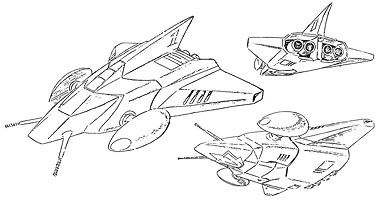
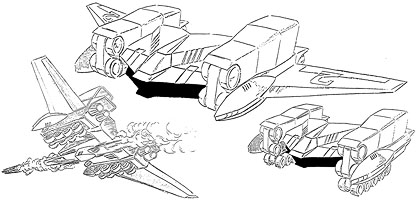
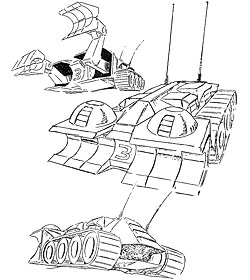
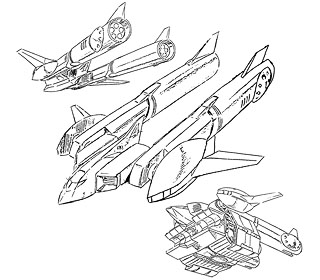
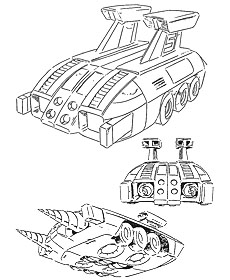
Final setting art for Battle Jet, Battle Crasher, Battle Tank, Battle Marine, and Battle Craft. Battle Jet was designed by Bandai and cleaned up by Yoshikazu Yasuhiko, while Yasuhiko is credited with basic design for the other four mecha. Studio Nue provided detail and weapons setting.
Naturally, Yasuhiko also handled the design of the human characters, giving them a more appealing appearance than the previous interpretations that had so distressed Nagahama.
Yoshikazu Yasuhiko — Yoshikazu Yasuhiko Design Note
With Com-V, they were okayed virtually in one go, and since the templates were already done, I only had to adjust them a little. Reflecting on Reideen, I gave them shorter legs and made the characters a little rounder and more comical. Mr. (Tadao) Nagahama had few complaints, but Juzo (Naniwa) was too handsome, so I toned him down.
Though Yasuhiko had served as animation director for a substantial portion of Reideen, he wasn't deeply involved on Com-Battler V, with an animator director co-credit on just two of its 54 episodes (as well as six storyboard credits). The animation direction was handled largely by Mushi Pro veteran Akihiro Kanayama, who worked on every episode and would make his debut as a character designer on the followup Voltes V.
☆ Click the image thumbnails below to see them at full size! ☆
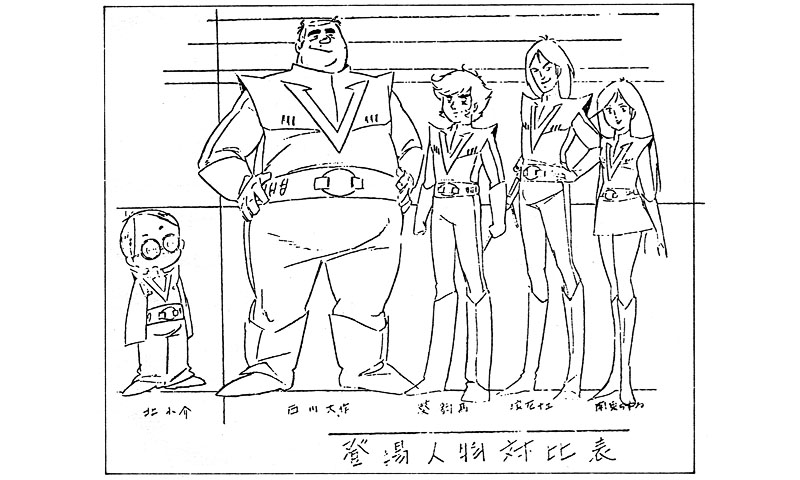
Com-Battler V character comparison chart by Yoshikazu Yasuhiko.
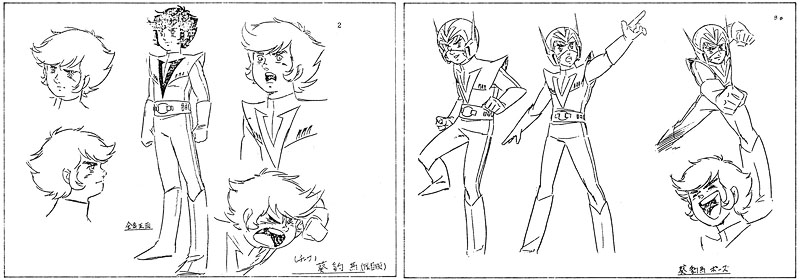
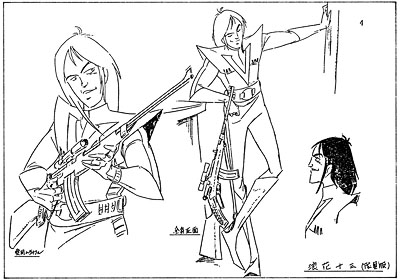
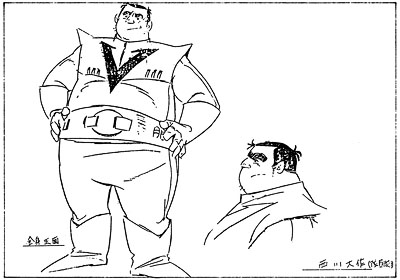
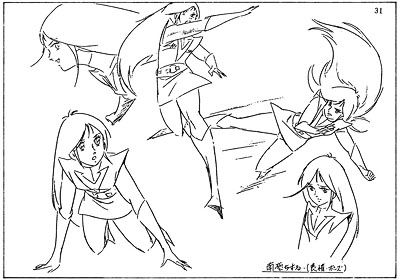
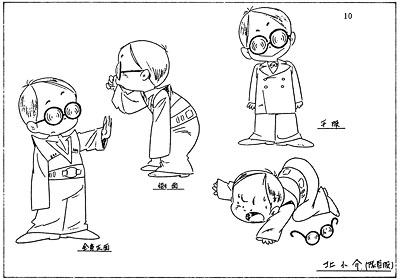
Hyoma Aoi, Juzo Naniwa, Daisaku Nishikawa, Chizuru Nanbara, and Kosuke Kita character setting art by Yoshikazu Yasuhiko.
One particular innovation carried over from Reideen was the handsome enemy commander, represented in that series by Prince Sharkin and in Com-Battler V by the enemy general Garuda. This motif would become a Nagahama trademark, as well as a direct inspiration for Char Aznable in the Gundam series.
Tadao Nagahama — Roman Robo Anime Climax Selection
Meanwhile, we were also working on something that would have a major impact on subsequent robot shows—the setting for the enemy side. Up until then, the enemy were usually all bad guys, hideous in form and figure. But here, I tried to create a drama highlighting the tragedy of the enemy side, whose destiny in a robot show is to be destroyed. I created a kind of drama I'd never been able to contemplate before.
To do this, I needed a character who would be beautiful in appearance, rather than the previous hideous enemies. This was the origin of the beautiful villains who would be so widely discussed afterwards. Unaware that he was an android created by his mother Oleanna, and then betrayed by this mother who he worships—this also evoked the sorrow of today's young people, who are forced to study like robots under a strict system of entrance exams.
Takashi Iijima — Roman Album 16: Combattler V
We decided to keep Garuda's tragic fate a secret. If people knew how it was going to end, it would be boring. With this weighty drama in mind, we began giving him more and more scenes in the film, and in Mr. Nagahama's fashion, he kept on pushing to go even further. Inevitably, Garuda started to feel like the protagonist, but I think that was fine.
☆ Click the image thumbnails below to see them at full size! ☆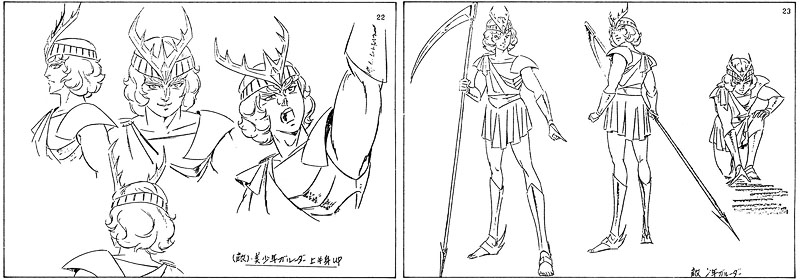
Garuda character setting art by Yoshikazu Yasuhiko.
The final step was fleshing out the details of the robot and its component mecha, including their various weapons and special attacks. After intensive brainstorming by the creative staff, writer Haruka Takachiho and illustrator Kazutaka Miyatake of Studio Nue were entrusted with documenting this technical setting and drawing up the model sheets.
Tadao Nagahama — Roman Robo Anime Climax Selection
We gathered Mr. Takachiho of Studio Nue, the writers Mr. Masaki Tsuji and Mr. Yoshitake Suzuki, the episode directors Mr. Tomino, Mr. Satoshi Dezaki, and Mr. Terada, as well as Mr. Yamaura of the planning office (who it seems is using the name "Hajime Yatate" nowadays). We held a series of exhaustive meetings, from which were born things like the super electromagnetic yo-yo, the super electromagnetic spin, and the super electromagnetic tornado. When we all worked together to create the super electromagnetic yo-yo, Mr. Yamaura groaned "It's such a waste to give this to Toei! Let's save it for when we're working on a Sunrise plan!"
It's true that everything we created there belonged to the planners, and in the end it didn't belong to us personally, or even to Sunrise. This frustration would later be the driving force behind the creation of Sunrise-planned works such as Zambot 3.
Haruka Takachiho — Atom's Genes, Gundam's Dream Episode 10
On Reideen and Com-Battler, I was in charge of the weapons setting. I gave them various names like "Dospressure," and I enjoyed creating such things so freely. (Though you can't do that in SF...) Director Nagahama asked, "Any ideas for good weapons?" I told him they used yo-yos in Sukeban Deka, so he went ahead with that... (laughs) "Let's go with a yo-yo," he said...
But since they were using it in Sukeban Deka, he said we should pay our respects to the original creator, Mr. Shinji Wada. We called him up and asked if we could borrow his yo-yo. Mr. Wada gave his OK, saying, "I'll lend it to you." That's how sensitive Mr. Nagahama was.
Haruka Takachiho — Roman Album 16: Combattler V
The mecha setting for Mr. Yasuhiko's character designs was created at Nue. Since there wasn't much time before we went on the air, Kazutaka Miyatake, who was responsible for this, took up residence at Sunrise and created model sheets for things like the main mecha, base interiors, and attack patterns one after another. Mr. Nagahama's orders were detailed and precise, so he could work quite efficiently.
After two or three weeks of intensive effort, during which the robot and character designs were revised and the weapon setting created, the plan was finalized at last and production could begin in earnest.
☆ Click the image thumbnails below to see them at full size! ☆
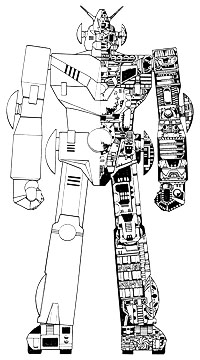
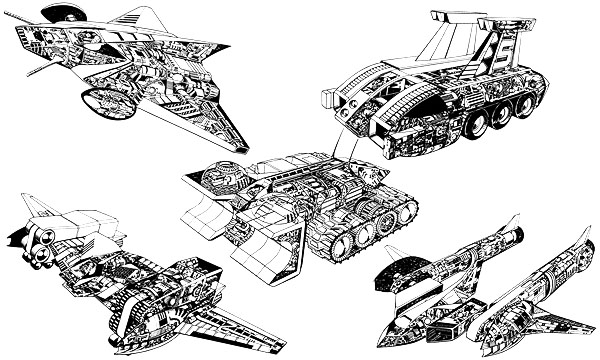
Internal cutaway diagrams of Com-Battler V and its component mecha by Studio Nue.

Exterior and interior views of the Nanbara Connection, the heroes' base. This was designed by Studio Nue, from an original concept by Popy's Katsushi Murakami.
The Sunrise Studio staff were reorganized in preparation for this major new undertaking. The cream of the Reideen production staff were transferred from Studio 1 to Studio 2, where they were merged with the remaining crew from the recently concluded Star of La Seine.
Yoshie Kawahara — Great Mechanics G, 2015 Spring
Director Nagahama and the rest of the Reideen production crew moved on to a new program produced by Toei, Super Electromagnetic Robo Com-Battler V. Rather than Studio 1, on the second floor above a coffee shop, their new production site was Studio 2, where the production of Star of La Seine had now ended.
Yoshie Kawahara — Great Mechanics G, 2015 Autumn
Studio 2 inherited the main staff from Reideen the Brave, who did the actual production work on the Toei-produced Super Electromagnetic Robo Com-Battler V, as well as the following Super Electromagnetic Machine Voltes V and Fighting General Daimos. But while I say "main staff," in fact many of its members were carried over from the La Seine crew, and in terms of the production site it might be more accurate to call it a mixed team from Reideen and La Seine.
The remaining production staff of Studio 1, meanwhile, spent the next few months working on outsourced episodes of TV series by other companies, such as Tatsunoko's Gowapper-5 Gordam. Studio 1's fortunes would eventually revive with the launch of Robokko Beeton at the end of the year.
Yoshie Kawahara — Great Mechanics G, 2015 Spring
Meanwhile, after the production site moved to Studio 2, Studio 1 was making ends meet by subcontracting on other companies' works. But they were purely assisting on a limited number of episodes.
After all this frantic preparation, including the production headaches it caused for the sponsoring toymaker, Com-Battler V proved to be a definite success. The broadcast continued for 54 episodes, and was followed immediately by the successor series Voltes V and Daimos. These three works, all directed by Nagahama, produced by Toei, and animated by Sunrise, would later be remembered as the "Nagahama Romantic Robo series."
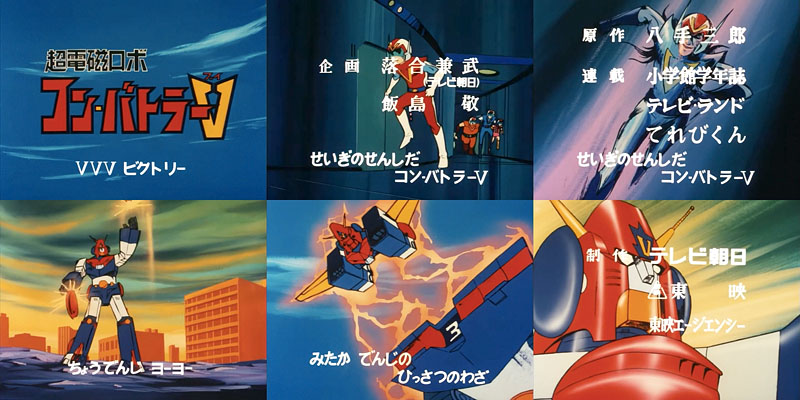
Scenes from Com-Battler V's opening credits.
Though the experience Sunrise gained through the Nagahama Romantic Robo series would be invaluable in launching its own giant robot works, I probably won't cover Voltes V and Daimos in depth, since they represent a separate creative lineage from the mainstream Sunrise history.
However, one creator intimately connected to Sunrise definitely benefited from working under Nagahama's leadership. After Nagahama replaced him as chief director on Reideen, Yoshiyuki Tomino not only continued working on that series, but went on to direct 13 episodes of Com-Battler V under his "Minoru Yokitani" alias, as well as six episodes of Voltes V under his own name.
Yoshiyuki Tomino — Complete Works of Yoshiyuki Tomino 1964-1999
—Com-Battler V was a joint production between Toei headquarters and Nippon Sunrise...
Sunrise was actually subcontracting for Toei, so that didn't matter, and I just did as I was told by Mr. Nagahama. Since it was a genuine giant robot show, the job was quite interesting. The "Nagahama style" of storytelling had been established during Star of the Giants, but up until then, I'd never thought the aura of someone merely exercising command authority as a chief director would be evident in the work itself. Watching Star of the Giants, especially the latter half, the Nagahama style was definitely there. Even though he was only commanding, it emanated from the work.
While Mr. Nagahama of course made revisions in general terms, these were purely generalities, and he didn't tinker with the particulars. He didn't have the ability to look at those kinds of details. I wondered what it was that enabled him to express the "Nagahama style" despite this. And when he was doing the giant robot show Com-Battler V, it was really interesting that he was able to create an anime with his own color merely by exercising command authority. I really hated working under Mr. Nagahama since he'd effectively stolen my job on Reideen, and I didn't think I could express the Nagahama style. But that's exactly why I wanted to steal it, and I tried to listen to every single thing he said.
—What happened when you actually tried it?
I see, I thought. As long as he had control of the planning stages, and the larger thematic setting and flow of each individual episode script, he could leave the rest to episode directors who had my level of physical technical skills. Looking at them one by one, the episodes might seem to have our colors. But in general terms, he had us by the scruffs of our necks. That's what I realized.
—It's just like Alfred Hitchcock Presents.
Exactly like that. It was like being able to direct an episode of Alfred Hitchcock Presents. To me, because I ended up being able to absorb all that knowhow, working on Com-Battler V was very interesting. And with the following Super Electromagnetic Machine Voltes V as well, I did it with the intention that if Mr. Nagahama was doing it, then I'd mechanically accept everything as I worked.
—In your own episodes of Com-Battler V and Voltes V, the flow was often a little different and there were particular accents. That was discussed in magazines like "Out."
I don't remember that, but in that case, I think it must have been because Mr. Nagahama recognized the position I was in. It wasn't something I was concerned about. I think he allowed it because I was more reliable on this kind of work than on Star of the Giants.
—In the end, I think you probably absorbed more from Mr. Nagahama's shows than anyone.
In that respect, perhaps so. The moment they called me in, I was determined to do as I've just described. I don't think the other episode directors had that kind of determination. They were people who'd never clearly considered whether they wanted to do contract work, or jobs that would put them in a position where they themselves were the original creators. There's a difference.
 恐竜探険隊ボーンフリー
恐竜探険隊ボーンフリー| TV BROADCAST | |||
| NET • Friday 6:00-6:30 PM October 1, 1976 to March 25, 1977 (25 episodes) |
This rather unusual work was a joint production between Soeisha and Tsuburaya Productions of "Ultraman" fame, with Tsuburaya handling the miniature model sequences and stop-motion dinosaurs, while Sunrise Studios provided traditional hand-drawn character animation. The "Sunrise Anime Super Data File" describes Born Free as follows:
In 1996, the close approach of Arby's Comet caused dramatic changes in the Earth's crust. With these changes, the dinosaurs that were believed to have disappeared began to revive. But severe climate disruption and shortages of food put the dinosaurs on the verge of a second extinction. The International Union for the Conservation of Nature forms the Born Free team to preserve these dinosaurs by transporting them to a safe island. However, the dinosaurs are targeted by the poacher King Butler...
This work combined anime with special effects using miniature models. Tsuburaya Productions was responsible for the special effects. It seems Tsuburaya took on this technological challenge based on its experience with 1974's Giant Beast Planet and 1975's Tsuburaya Three-Dimensional Anime. And Sunrise would later make use of this experience in its own independent production Tansar 5.
The previous Tsuburaya projects mentioned here, Giant Beast Planet and Tsuburaya Three-Dimensional Anime, were short pilot films less than three minutes long. Curious readers can learn more about these, and their relationship to Born Free, from this YouTube video:

Scenes from Born Free's opening credits. These consist mostly of Tsuburaya's trademark model work, with a couple of stop-motion dinosaurs and no hand-drawn character animation.
The character animation for Born Free was handled by Sunrise Studio 3. After the series ended, the studio was briefly uninhabited, but it would soon be revived as the production site for a landmark new project.
 ろぼっ子ビートン
ろぼっ子ビートン| TV BROADCAST | |||
| TBS • Tuesday 7:00-7:30 PM October 12, 1976 to September 27, 1977 (50 episodes) |
|||
| MAIN CREDITS | |||
| Original story | Masaaki Osumi Airship Planning |
Producer | Yasuo Shibue Tadashi Matsushima (Tokyu Agency) Masashi Tadakuma (TBS) |
| Music | Joe Hisaishi | Director (監督) |
Masaaki Osumi |
| Production | Tohokushinsha, Tokyu Agency | ||
| ADDITIONAL CREDITS | |||
| Literature manager | Kazuichi Tsurumi | Character design | Airship Planning Yoshikazu Yasuhiko |
| Art director | Katsumi Bando (ep.1~25) Mitsuki Nakamura (ep.26~50) |
Production manager (制作デスク) |
Toru Hasegawa |
The third Soeisha production of 1976, Robokko Beeton, was also its final work produced under the aegis of Tohokushinsha before relaunching as an independent company. The "Sunrise Anime Super Data File" describes Robokko Beeton as follows:
Ma-chan receives a robot assembly kit from his uncle in America. When he builds it with the local inventor Mr. Nobel, parts from a clock and a vacuum cleaner get mixed in, and somehow the completed robot Beeton ends up with a mind of its own. When the mean-spirited Gakioyaji and his robot Burikin get involved, the neighborhood will be in an uproar again...
A daily-life gag anime revolving around Ma-chan and Beeton. Ultimately it was Gakioyaki, an adult who's nonetheless the neighborhood bully, who left the strongest impression. It also featured robot characters such as Gakioyaji's super-strong Burikin, and the beautiful girl robot Nennen who behaves in an oddly sexy manner, which were designed by Yoshikazu Yasuhiko.
As a comedy series focusing on an elementary-school student and his robot friend, Beeton could perhaps be seen as a precursor to lighter Sunrise works such as The Unchallengeable Trider G7 and Super Robot Galatt. It's also notable as an example of Yoshikazu Yasuhiko working purely as an animator rather than an original creator, creating model sheets based on another artist's designs and supervising them as the show's main animation director.
☆ Click the image thumbnails below to see them at full size! ☆
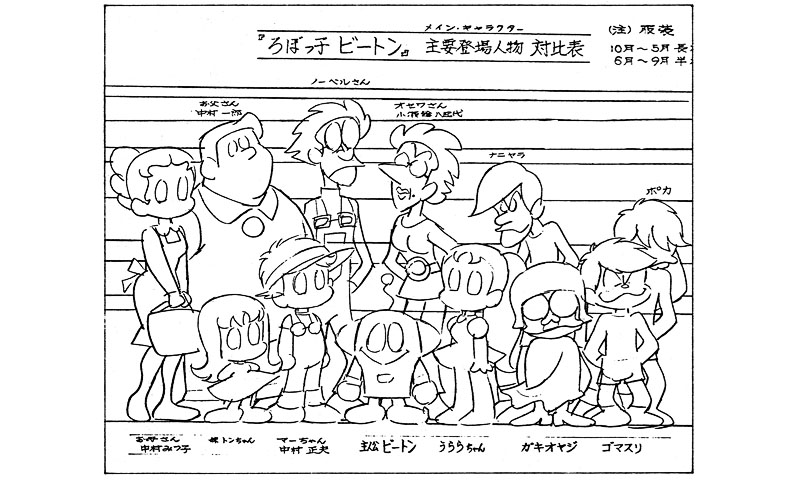
Robokko Beeton character comparison chart by Yoshikazu Yasuhiko.
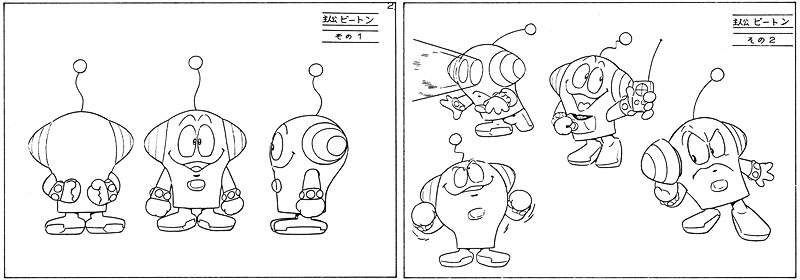
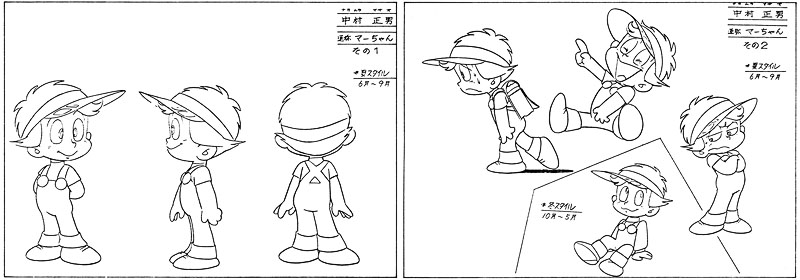
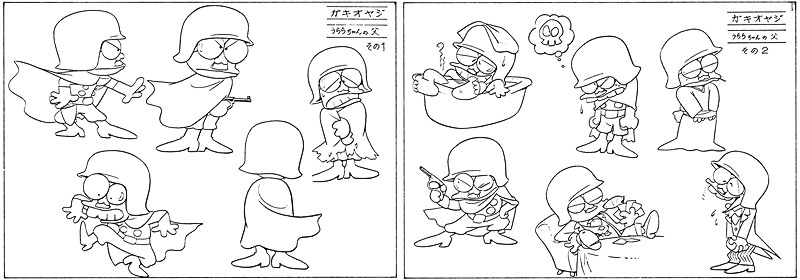
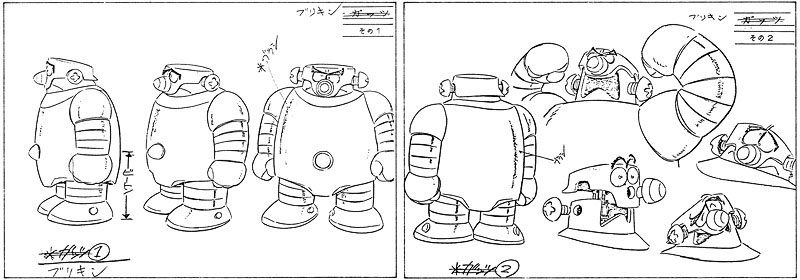
Beeton, Ma-chan, Gakioyaji ("bratty old man"), and Burikin character setting art by Yoshikazu Yasuhiko.
Though it's fairly obscure today, this series consumed a considerable amount of Yasuhiko's time during its one-year broadcast run. In total, he was credited or co-credited as animation director on 41 of its 50 episodes. During the second half of the series, his art direction credits were listed as "Yasuhiko Tadano," which in Japanese name order means "It's just Yasuhiko."
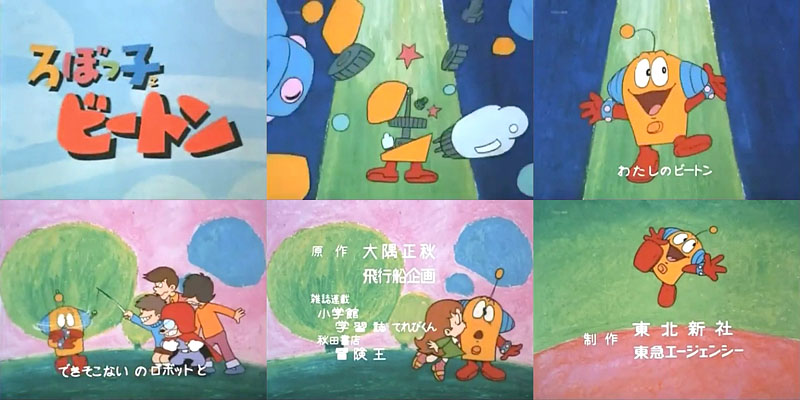
Scenes from Robokko Beeton's opening credits.
In her "Coelacanth Kazama's True Stories" series for "Great Mechanics" magazine, Yoshie Kawahara argues that Beeton is actually an underrated "hidden masterpiece."
Yoshie Kawahara — Great Mechanics G, 2015 Summer
After the Com-Battler crew relocated to Studio 2, which had previously been used for the production of Star of La Seine, Studio 1 was placed in charge of this new program. The series director, Mr. Masaaki Osumi, was also famous for directing the first Lupin III. This was the first time I'd personally met him, but he'd also worked on Star of La Seine. The episode directors included Mr. Takao Yotsuji, who I've discussed previously, as well as Mr. Satoshi Dezaki, Mr. Masuji Harata, and Mr. Yoshiyuki Tomino.
You'll already know about Mr. Tomino. Satoshi Dezaki, the older brother of Mr. Osamu Dezaki of Tomorrow's Joe and Treasure Island fame, came from Mushi Production and had previously worked on Reideen and La Seine. He was a calm and dapper person. Mr. Masuji Harata was a member of Akabanten, a group that also included Director Ryosuke Takahashi of Armored Trooper Votoms, and he was a unique character who loved jokes.
The character designer, Mr. Yoshikazu Yasuhiko, was also working on Com-Battler but that's what makes him a genius. He actually participated in the planning of this work, and in addition to the guest characters for each episode, he sometimes handled the scripting and direction as well. He also did animation direction under the credit "Yasuhiko Tadano."
In a sense, Robokko Beeton was the polar opposite of the straightforward giant robot show Com-Battler. Though it was supposed to be family-oriented, it certainly wasn't a well-mannered work. In particular, the rival of the grade-schooler hero was a wild "bratty old man" with a little mustache, who was immensely wealthy but remained mentally childish. As it continued, it went in a somewhat slapstick direction, and with things like the appearance of a sexy girl robot in the second half, I think it became a hidden masterpiece whose sensibilities were beyond anything people expected at the time. Thinking back on it now, this wildness was probably due to the presence of so many Mushi Production alumni around Sunrise.
Particularly noteworthy for the readers is the fact that Beeton was actually the first Sunrise work with which Mr. Kunio Okawara was involved. It was Mr. Okawara who did the internal diagrams of the robot Beeton, the hero's partner who served as a second protagonist. These were meant for publication in things like the children's magazines that were running the Beeton manga, so perhaps some veteran readers may have seen them when they were children.
In November 1976, one month after the debut of Robokko Beeton, Soeisha merged with its Sunrise Studio production division and relaunched as the independent Nippon Sunrise Inc. I'm now documenting the next chapter in this saga in Nippon Sunrise 1976~1987...
Mobile Suit Gundam is copyright © Sotsu • Sunrise. Everything else on this site, and all original text and pictures, are copyright Mark Simmons.